


PREGNANCY | BIRTH | PARENTING ISSUE 23 / 2017 | $3.95 | health4mom.org DO THIS INSTEAD OF SELF-EXAM POWERED BY THE NURSES OF WOULD YOU CONSUME YOUR BABY’S PLACENTA? BREAST SELF-AWARENESS BLEEDING IN PREGNANCY Have you Experienced MOMMY SHAMING? BABY SHOWERS MADE EXCITING! What it means; when to get help





healthy moms
10 The Mommy Shame Game
Learning the ropes as a new mom is tough— and it’s even harder when you have criticism from those dearest to you
11 Understanding Women’s Health Screening

Figuring out which health screens and tests you may need is easy with our guide
12 Mastitis: Understanding this Painful Nursing Complication
Learn how to prevent and treat this common breastfeeding condition
14 Ask a Pharmacist: Managing Medications
Adults and babies have different medication needs and instructions—here’s help on how to make sense of it all
17 Breast Self-Awareness
Breast self-exams are no longer recommended for early detection of breast cancer, but here’s why you should still practice “breast self-awareness”
19 Fill Your Plate with Folate!
Folate is super important for moms-to-be
20 Is it Safe to Consume Your Baby’s Placenta?
Consuming the placenta is trendy; here’s what you need to know about the risks
21 Prevent Cytomegalovirus in Pregnancy
This common virus can cause serious complications for your baby
healthy pregnancy
24 Morning Sickness, Prenatal Vitamins, Your Changing Pregnant Body
Our nurses answer your questions
25 Negative Blood Factor?


A positive or negative Rh factor doesn’t affect your health status but it may affect your pregnancy
26 Prepare for a Natural Childbirth
Natural birth doesn’t have to be scary or intimidating. If you prepare mentally and physically, it can be beautiful and empowering
29 Shake Up Your Next Baby Shower
Baby showers are the latest time-honored tradition to get a more modern makeover
33 Choose Your Birth Environment
You have choices when it comes to where you will birth
37 Preparing for Breastfeeding
Create breastfeeding success with a little planning, support and these checklists
40 Bleeding in Pregnancy
Bleeding during pregnancy can scare moms-tobe, however, not all bleeding during pregnancy is a sign that something is wrong
healthy babies
45 Understanding Trisomy
Trisomy happens when a baby is born with an extra chromosome; you may have heard about it as Down, Edwards or Patau syndromes
46 Caring for Your Late Preterm Infant
Babies born just 3 to 6 weeks early are at a greater risk for potentially serious health problems than babies born at term
49 Breastfeeding & Postpartum Depression
Lactation consultants answer your questions
50 Developmental Diapering: Comfort and Care
You may not know it yet but you can slow down and intentionally diaper with comfort and care to reduce pain and avoid stressing baby
55 Bond with Your Baby
Parenting isn’t just a responsibility—it’s the opportunity to build a bond with your baby that will last a lifetime
59 Prevent Poisonings
Your wee ones are interested in their world, but simple household items can be harmful

60 Newborn Thyroid Conditions
Newborn thyroid conditions can affect baby’s growth and development. Newborn screening is essential for early detection and intervention
61 Vaginal Seeding: Sound Science or Just a Trend?
Vaginal seeding may sound like a good idea in theory, but healthcare providers are cautioning against it
63 Potty Training 101
Don’t get down in the dumps helping your kiddo conquer the commode
66 Choosing Baby’s Day Care
If you plan to return to work after baby is born, finding the best possible day care for your little one is essential
ON OUR COVER
Courtney Duggan and son Maxwell take in a gorgeous day at the park in Washington, DC.

Photo by Jenn Gorrie; glorriephoto.com
Send your images to health4mom@awhonn.org.
Issue 23 / 2017
21 Want to appear on our cover? ISSUE 23 / 2017 Healthy Mom&Baby 3
The best for your baby since 1961

Classically chic products handmade in France with all natural materials www.sophiethegiraffe-usa.com


Proper Nutrition is the foundation for a Healthy
O-Cal Prenatal



Complete Formulation: 16 vitamins and minerals including Folic Acid. Small easy to swallow tablet, gentle on the system and gluten free. Only 17¢ per day.
Ferretts Iron

Oral tablets, chewable tablets or liquid. Gentle, effective, and easy on the stomach. Ferretts IPS is non-constipating. Better tolerated for better results.
O-Cal-ette Nursing Cups


Breast-feeding should be enjoyable, not painful. Protects sore or cracked nipples, helps provide relief from engorgement. Collects excess breast milk.

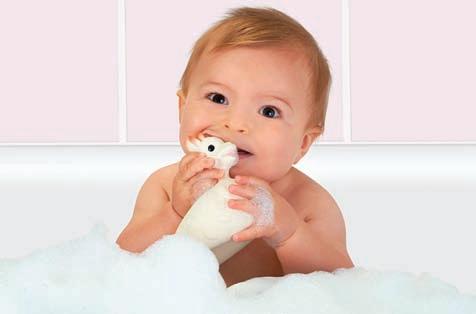




Free shipping with Coupon Code HMB (coupon expires 12/31/2018)
*These statements have not been evaluated by the FDA. These products are not intended to diagnose, treat, cure or prevent any disease.

Are you getting the nutrients you need? Call 800-456-4138 or www.Pharmics.com
Life
CANDACE ANN CAMPBELL , DNP, RN, CNL
University of San Francisco Concord, CA
ROBERTA DURHAM, RN, PhD California State University East Bay Hayward, CA
JOANNE GOLDBORT, PhD, RN Michigan State University East Lansing, MI
HELEN M. HURST, DNP, RNC-OB, APRN-CNM University of Louisiana School of Nursing Lafayette, LA
ELIZABETH JORDAN, DNSc, RNC FAAN
University of South Florida College of Nursing Tampa, FL
CAROLYN “CARRIE” LEE, PhD, MSN, CNE, RN
University of Toledo College of Nursing Toledo, OH
JENNIFER LEMOINE, DNP, APRN, NNP-BC University of Louisiana at Lafayette Lafayette, LA
RITA NUTT, DNP, RN Salisbury University Salisbury, MD
SUSAN PECK, MSN, APN Summit Medical Group Cedar Knolls, NJ
MICHELE SAVIN, MSN, NNP-BC Christiana Health Services Wilmington, DE
PAT SCHEANS, MSN, NNP Legacy Health System Portland, OR
SHARON JEAN SCOTT, DNP, MSN, RN Germanna Community College Locust Grove, VA
JAMIE M. VINCENT, MSN, RNC-OB, C-EFM John Muir Medical Center Walnut Creek, CA
KIMBERLY WILSCHEK, RN, CCE Medical Revenue Solutions Chicago, IL
CHARLOTTE WOOL, PhD, RN, CCNS York College of Pennsylvania York, PA
TAMERA YOUNG, RN, MSN
Central Ohio Technical College Zanesville, OH
CONSUMER ADVISORS
MARIA OPLT
Lafayette, LA
Join us on Facebook facebook.com/HealthyMomAndBaby

AWHONN’s mission is to improve and promote the health of women and babies. Healthy Mom&Baby is powered by the nurses of AWHONN.
 BY EMILY DRAKE, PHD, RN, FAAN
BY EMILY DRAKE, PHD, RN, FAAN
Born Early When your baby is
Late preterm infants—this is what healthcare providers call babies who are born just a little early. Babies born between 34 and 36 completed weeks are still growing and need your attentive care. Their brain is still developing. Your baby may look and act like a full-term baby, but they’re not.
Be gentle; not too much stimulation. Respond quickly to crying or fussiness. Crying can be especially stressful for babies born early.
Your baby’s lungs are still developing; this means you should call 911 or baby’s healthcare provider right away if you see rapid breathing or if baby starts turning blue.
NURSING YOUR BABY BORN EARLY Patience is key when nursing or feeding a baby born a little early. They’re still coordinating sucking and swallowing, and their suck reflex may be a little weak. Breastfeed often—every 1-3 hours or feed expressed milk in a bottle to nourish, boost baby’s immune system and help protect them from getting sick.
Your nurses will help you monitor baby’s weight, and you can track baby’s diapers to see that they are getting plenty of fluid and calories for good growth.
Protect baby’s sleep. Always put baby to sleep on their back, on a firm mattress without anything else except a tight-fitting sheet. Keep baby warm, but not over-heated; dress baby in as many layers as you would wear plus one more.

Protect baby’s health. Wash your hands each time before holding or touching baby. Keep baby away from people who are sick. Prohibit smoking around your baby born early. Protect baby with up-to-date immunizations for everyone who cares for them. Ask your nurse how to accurately take baby’s temperature before you leave the hospital. And don’t hesitate to call your nurses if you have any questions after you’re home.
Your baby born early will likely need extra check-ups in the first few weeks; these are important. Lastly, trust your gut; if you’re concerned, call 911, call your nurses or return to the hospital—we’re always happy to help with advice and care!
EMILY DRAKE, PHD, RN, FAAN, is the AWHONN 2017 President.
IMAGE: SHUTTERSTOCK
HEALTHY MOM&BABY EXPERT ADVISORY BOARD ISSUE 23 / 2017 Healthy Mom&Baby 5
Pump Easy with the Haakaa Silicone Breast Pump!

Breastfeeding for new moms can be frightening and frustrating. “How do I pump? What pump should I use? Will it hurt? What if I can’t produce milk? What if I produce too much milk?”
For the experienced moms, it really becomes an issue of convenience: “I need something quick; I need something easy; I need something discrete; I need something small and portable.”
THE BIG DIFFERENCE
To meet the needs of both the new mom and the experienced mom, there are many options for breast pumps, but there are basically two types: manual and electric. The big difference is who does the work – mom or pump? All breast pumps have to attach to the breast and that’s done with suction. All pumps regardless of manual or electric have a large suction cup (flange) that comfortably fits over and attaches to the breast. With some “suction encouragement,” the milk then flows from the breast into a collector.
PUMP EASY WITH HAAKAA
The Haakaa pump is a welcome variation of the manual pump. By gently squeezing the bottom of the pump to apply suction, attach the pump to the breast while breastfeeing on the other side to catch the letdown that would otherwise go to waste. Once the milk is collected, you can store it for later by either refrigerating for up to 5 days or for 6-12 months in an upright deep freezer. The Haakaa breast pump is an effective method of expressing breastmilk. Unlike traditional manual pumps, Haakaa pump has only one piece with no parts to assemble, making it easy to use and clean. It fits easily in a purse or diaper bag—perfect for traveling and pumping on the go.

Place top of pump over your nipplemake sure your nipple is in the neck of the pump and comfortable.

Apply suction. Once the pump is secure and comfortable, you can squeeze the base of the pump to create some movement.


RECENT AMAZON REVIEWS






Lindsey:
This pump changed my life! Going back to work soon and pumping seems so daunting, but this thing works magic on one side while nursing on the other. It’s also great for expressing a bit of milk before baby nurses if you’re too full or have a fast let down. I get the same ounces during nursing as l did using an electric pump after nursing, and clean up is a breeze!
Princess K:
The best pump I have ever seen and used!
I like the simplicity of this product. Material used looks of high quality and durable. It really does the work. I like this above all other pump because first it is easy to clean and sterilize. Second, it comes in one piece( except of course for the cover which is optional). Third no batteries or electricity needed.
Once milk begins to flow simply leave the pump alone to do its thing. Once the pump becomes full, empty it into a glass storage bottle.
Dana:
Five weeks post-partum with first [baby] and started pumping with this only to get a freezer stash going. This is so easy. I pump on the opposite side when [my son] is feeding. Getting between two to four ounces by just pumping on one side during these 20-35 minute feedings.
LOVE LOVE LOVE.
haakaausa.com Haakaa Silicone Breast Pump (4 oz) and Silicone Flower Stopper Set available in more colors
Subscribe now!
for 4 issues!
Go to health4mom.org/magazinesubscription
or fill out the form below:
Please send me 4 issues of Healthy Mom&Baby for $13.95.
Name: Address: City: State/Zip:
Check One:
Credit Card
Card Type:
Name on card:



Credit Card No: Exp. Date:








Signature:












Check Money Order
Call us at 312-572-7729
or mail payment to: Maitland Warne, 123 W. Madison St. Suite 1600, Chicago, IL 60602, USA. Make checks payable to Maitland Warne.

AWHONN
AWHONN 2017 President Emily Drake, PhD, RN, FAAN
Chief Executive Offi cer Lynn Erdman, MN, RN, FAAN
Vice President; Marketing, Communication & Publications
Tom Quash, CAE
Editor-in-Chief & Director of Publications
Carolyn Davis Cockey, MLS, LCCE
Director of Women’s Health Catherine Ruhl, CNM, MS
Assistant Managing Editor & Writer Summer Hunt, ELS
MAITLAND WARNE
Group CEO & Publisher
Kevin Harrington
EDITORIAL
Managing Editor: Kayley Loveridge

DESIGN

Art Editor: Friyan Mehta

ADMINISTRATION
Production Director: Jo Harrington
Production Coordinator: Chloe Adegoke
Printed in the United States on paper made with 30% post-consumer recycled fiber. Please recycle this magazine!

Healthy Mom&Baby is published by Maitland Warne in partnership with AWHONN.

© AWHONN, 2017. All rights reserved. All material in Healthy Mom&Baby is wholly copyright. Reproduction without the written permission of the publisher is strictly forbidden.


Neither this magazine nor its contents constitute an explicit or implied endorsement by AWHONN or by Maitland Warne of the products or services mentioned in advertising or editorial content. The editorial content in this publication does not necessarily represent policies or recommendations by AWHONN. This publication is not intended to be exhaustive. While every effort has been made to ensure accuracy, neither AWHONN nor Maitland Warne shall have any liability for any errors or omissions. Readers who may have questions should consult their healthcare provider.
is is NOT Your Mother’s Pregnancy or Baby Shower
Gone are the days when a mom-tobe is feted and celebrated by guessing the number of toilet paper squares it takes to encircle her bump or competing to see how many words can be made from baby’s proposed full name by her best girlfriends and female relatives. Today’s baby showers are all out family-and-friends-style parties with themes, activities and creative new ways to help provide parents with the gifts and resources they’ll need to raise their young one. From pizza parties to book-themed gatherings, we’ve got innovative baby shower ideas beginning on page 29.
And speaking of trendy, we bet your mom may have never considered consuming the placenta post-birth, or asking her healthcare provider to share her vaginal microbiome with you via a practice called vaginal seeding. Have you heard about these latest trends? They each come with their own cautions, so we’ve got the latest evidence about what’s safe—or not—for you and your baby, see pages 20 and 61.
Prepping to breastfeed is also easy when you follow the advice from one of our midwife advisers on page 37. One of the best ways to prepare is to take a class on breastfeeding at your chosen birth place or sit in with nursing moms at a lactation support group near you. Nursing moms are typically eager to share support and advice, particularly related to breastfeeding concerns like mastitis (page 12) or whether breastfeeding can cause postpartum depression (page 49).
Find all of this in this issue, and more online at health4mom.org where the nurses of AWHONN are eager to answer your questions and share advice backed by the latest research to help you have the healthiest pregnancy, labor and birth possible.
Until next time,


PUBLISHER
MAITLAND WARNE 123 W Madison Street, Suite 1600, Chicago, IL 60602, USA Tel: (312) 572-7727 Fax: (312) 284-5864 www.maitlandwarne.com
EDITORIAL INQUIRIES


AWHONN Carolyn Davis Cockey, MLS, LCCE carolyndc@awhonn.org
3 Shoreland Drive | Osprey, FL 34229



Tel: (877) 377-5326 www.AWHONN.org
Carolyn Davis Cockey, MLS, LCCE
Editor-in-Chief & AWHONN Director of Publications
Health4Mom@AWHONN.org

HEALTH4MOM.ORG MOM&BABY ISSUE SPRING 2012 ISSUE Summer2012 health4mom.org PREGNANCY BIRTH LIFE CouldYourBaby HAVE HIGH CHOLESTEROL? SUMMER FIT TO PLAY SNEAKY EATS Twins, Triplets, MANAGING MULTIPLES CORD BLOOD BREAKTHROUGHS Oh My!PREGNANCY POISON 101 GOOD SLEEP ✿ NESTING ✿ GO THE FULL 40 IVF GUIDE ✿ YOUR STORY ✿ PUMPING COVER_HM&B_9_12.indd DIABETES ✿ TEXT4BABY ✿ GO THE FULL 40 DIAPERING ✿ JAUNDICE ✿ BABY BUDGETISSUE Winter 2011 $3.95 health4mom.org PREGNANCY BIRTH LIFE the BABY FRIENDLY BIRTHPLACES Natural Birth KEEPSAKE ultrasounds BEST EVER GIFTS FOR ANDBABY YOU Choosing FASHION & Weight Loss Surgery HEALTH4MOM.ORG HEALTHY MOM&BABY ISSUE COVER_HMB_7-Dec2011.indd
$13.95
7ISSUE 23 / 2017 Healthy Mom&Baby
If you’ve ever experienced the stress and frustration of low milk supply, then you may relate to Jenny’s story. Shortly after giving birth to her first child Kayla, Jenny noticed a drop in her milk supply. Worried that she wouldn’t be able to provide enough milk for her baby, she became determined to find a natural solution to safely and quickly boost her supply. She soon learned that she was not alone, and that millions of mothers had experienced the same frustrations and challenges that Jenny had experienced as a new mom when it came to low milk production.
With that, Mommy Knows Best was conceived.

Today, MommyKnowsBest.com provides an assortment of lactation supplements containing all natural herbal remedies, traditionally and effectively used for generations to treat low milk supply. Created with the health and safety of both mom and baby in mind, Mommy Knows Best gives you plenty of options for all your breastfeeding plans.












Made In The USA • Not Tested On Animals • Veggie Caps • Vegan Friendly • No Artificial Ingredients • GMO-Free • Hypoallergenic Herbal Supplements Breastfeeding Accessories & More! Lactation Cookie Mix Lactation Fruit Drink Mixes Lactation & Breastfeeding Support for New Moms! info@MommyKnowsBest.com www.MommyKnowsBest.com 800-323-2510 Save 15% at www.MommyKnowsBest.com when you use promo code MOMMY15 Also Available on
BY SUMMER HUNT, ELS
Pet Prescription
Fluffy or Fido could be the key to a healthier baby, say researchers. They found that infants who were exposed to at least 1 furry pet before or after birth had higher levels of good bacteria—specifically, the kind that fight off allergies and obesity.

Shift kitty litter duties to another member of your household if you’re pregnant. Changing the litter carries the risk of contracting toxoplasmosis, an infection with a parasite you could transmit during pregnancy to your little one. Babies exposed to the parasite during pregnancy can be born with weakened immune systems and experience serious complications. And you may want to avoid any on-the-mouth puppy kisses until baby is born as they can pass on germs too.
OH, THE PLACES YOU WILL PUMP!
Here, there, everywhere—especially if you make use of the Moms Pump Here app. Available on iTunes and the Google Play store, this app helps breastfeeding mamas fi nd clean, safe spaces to pump or nurse no matter where they are. Moms Pump Here uses GPS to pinpoint nearby locations that have been reported and vetted by other moms, complete with tips from users about their experiences.

CERVICAL CANCER SCREENING RECOMMENDATIONS


















Good news regarding cervical cancer screening: In new draft recommendations, the US Preventive Services Task Force says if you’re 30 and older, you may be able to choose to have a pap smear every 3 years or HPV testing every 5 years. This recommendation updates previous advice that suggested having both screens at the same time. If you’re between ages 21 and 29, the recommendations remain the same: Pap smear only every 3 years.


ISSUE 23 / 2017 Healthy Mom&Baby 9
MomshealthyJoin us on Facebook facebook.com/HealthyMomAndBaby
IMAGES © SHUTTERSTOCK
By Summer Hunt, e LS
The Mommy
Shame Game
Learning the ropes as a new mom is tough—and it’s even harder when you have to deal with criticism from those nearest and dearest to you.
Have you ever felt judgmental glances from family or friends when it comes to parenting? You’re not alone: 6 in 10 mothers of young children say they’ve been criticized on everything from discipline to breastfeeding, according to a University of Michigan poll.

What’s surprising? The most frequent offenders are a mom’s own parents, followed by the child’s other parent and in-laws. Moms report far less criticism from friends, other mothers they encounter in public, social media commenters, and their child’s health or care providers.
Summer Hunt, eLS, is editorial coordinator for publications at AWHO nn in Washington, DC, and writer for Healthy Mom&Baby
37%
have felt secondguessed by their mother or father
42%
say criticism has made them feel unsure about their parenting choices—but it has also pushed them to be proactive and consult a healthcare provider for advice
56%
believe moms get too much blame and not enough credit for their children’s behavior
Half of moms surveyed said they simply avoid super-critical people

Here’s w H at moms say: moms get criticism most often about:
discipline 70% diet and nutrition 52% sleep 46% breast- vs. bottlefeeding 39% safety 20% child care 16%
Feeling pushedaround? tell yournurse and askfor their advicein the safety of ashame-free zone.
10 health4mom.org images: s HUTT eRs TOCK; m OTT pO ll. OR g healthy moms
By Su S an Peck, MS n , aPn
Understanding Women’s Health Screening
Figuring out which health screens and tests you may need and when can be confusing—here’s your guide to sorting it out.
Until recently, women routinely visited their gynecologist once a year for a full exam plus an annual Pap smear to screen for cervical cancer. But things have changed as we’ve learned that more frequent screening isn’t always better screening. In case you’re confused, here are the latest recommendations.



a nnual Well-Wo M an e xa M
your annual exam is so much more than a Pap smear! It covers your general health, birth control, sexual activity, menstrual periods and more. you’ll have your breasts, ovaries and uterus examined, too. So please keep this annual appointment—it’s an important part of your own preventive healthcare.
Pap smears screen for cervical cancer, including pre-cancer. During a Pap, your healthcare provider takes a small collection of cells from your cervix and sends it to a lab for testing. you should begin screening for cervical cancer at age 21, even if you’re not yet sexually active.
as long as your first Pap is normal, you can space screening out to every 3 years until age 30, at which time your care provider is also likely to add HPV (human papillomavirus) screening to your exam. If both tests are negative, your risk of cervical cancer and even cervical pre-cancer is very, very low, and it’s safe to continue extending the screening interval. Some healthcare providers will test again in 5 years, and others are more comfortable with 3 years—talk to your provider and see what they recommend for you.

If your Pap doesn’t yield normal results, you may just need another Pap in a year, not 3 years. If your next screen is also abnormal, or if you’re age 24 or older, your healthcare provider will likely advise a biopsy (colposcopy).
ST i S C reening
If you’re 25 years old or younger, your healthcare provider will test once a year for chlamydia and gonorrhea infections, as recommended by the cDc. you can request testing at any time if you’re concerned about these sexually transmitted infections. The cDc also recommends that you get tested for HIV at least once after age 13.
Su S an Peck, MS n , aPn, is an expert adviser to Healthy Mom&Baby.
Ma MM ography
a mammogram is an x-ray of your breast to screen for cancer. For most women, mammography begins around age 40, as recommended by the american college of Obstetricians and Gynecologists; other groups say screening could be delayed up to your 50th birthday. Talk to your healthcare provider about any incidences of breast cancer in your immediate and extended family—your care provider may modify these recommendations based on your personal risk.
Cervi C al Can C er
ISSUE 23 / 2017 Healthy Mom&Baby 11 healthy moms IM aGeS S Hu TT er STO ck
Mastitis: Understanding This Painful Nursing Complication
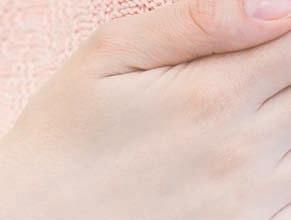 BY CHARLOTTE WOOL, PHD, RN
BY CHARLOTTE WOOL, PHD, RN
Baby is growing and nursing is going great! You and your newborn are hitting your groove when, WHAM!, you notice a hard, reddish hot area in your breast—you may even feel like you’re coming down with the flu. is familiar incidence among breastfeeding moms is called mastitis, a common breastfeeding complication that could lead to infection.
WHAT IS MASTITIS?
Mastitis typically begins as a lumpy, tender area in your breast caused by bacteria or a blocked milk duct. Usually these two issues will lead to an infection if not quickly addressed. Mastitis is most common in the early weeks of nursing.
Mastitis can develop several ways: being overly tired or stressed, having sore or cracked nipples, not alternating and emptying both breasts at each feeding, missed feedings, poor latch, injury to your breasts, your own illness or anything that may restrict milk flow, like a tight-fitting bra.



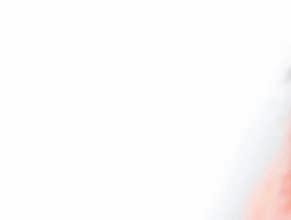
Signs of mastitis include a hot, reddened area in one or both breasts, including the areola and nipple. If you have mastitis, you may also have the sudden onset of fever, chills, body aches and headache.







TREATING MASTITIS
Call your midwife, nurse or lactation consultant at the fi rst signs of mastitis. If you’ve developed an infection, you’ll be asked to take antibiotics for 10-14 days. Discuss which antibiotic will be safe for you and baby so you can continue to nurse and what you can do if a yeast infection emerges while taking antibiotics, as it may for some women.
You may also be advised to take an anti-inflammatory medicine like ibuprofen for relief of pain and discomfort. Try to get extra rest during this time—you want to give your body every chance to fight the infection and get better quickly.
You can also try applying moist heat or ice to your breasts before nursing to ease the pains of mastitis. Heat can increase inflammation; cold can decrease swelling—see what works best and feels the most comfortable for you.



CONTINUE NURSING
Most importantly—as possible—keep breastfeeding! Suddenly stopping breastfeeding and weaning your infant will bring about other problems and put you at risk for complications like engorgement or developing a breast abscess, which is a puss-filled cyst within your breast.
Emptying your breasts is the best way to move mastitis toward healing. Start each feeding with your least painful breast and continue with frequent feedings to ensure your breasts don’t become overly full.
In very rare cases, some nursing moms will experience frequent bouts of mastitis—this could be a warning sign that you may have an underlying breast concern, such as a tumor or an abscess. Tell your nurse or lactation consultant if mastitis returns after your first episode resolves—you may need further screening to help identify why this complication is developing.
Mastitis usually comes on quickly and resolves with good selfcare and treatment. Getting mastitis is an opportunity to reach out to family and friends for support. Don’t be shy about asking for help in the form of healthful meals, light housekeeping, or childcare for older siblings.
CHARLOTTE WOOL, PHD, RN, i s an associate professor of nursing at York College of Pennsylvania and an expert adviser to Healthy Mom&Baby.
12 health4mom.org IMAGES: SHUTTERSTOCK healthy moms
Breastfeeding is beautiful... when it’s pain-free.


If breast irritation, inflammation, or mastitis develop, nursing is not so pleasant.






Dr. King’s Breast Inflammations & Discomforts™ is a safe, natural, homeopathic medicine* for both mom and baby. It temporarily relieves:




• Breast inflammation, mastitis

























• Breast tenderness





• Cracked, sore, or irritated nipples








*The claims for the HPUS** ingredients in our product are per various homeopathic materia medicas, as referenced by the U.S. Food and Drug Administration (FDA) Compliance Policy Guide for Homeopathic Drugs.





**HPUS indicates that the active ingredients in the product are monographed for safety and are listed in the official Homeopathic Pharmacopoeia of the United States, as recognized and regulated by the FDA. These claims and this product have not been evaluated by the FDA for safety or efficacy. The FDA is not aware of scientific evidence to support homeopathy as effective.

Since 1989, Dr. King has formulated more than 500 safe, natural, advanced homeopathic medicines with no known negative side effects. Buy this essentially taste-free, pure water based oral spray now, at DrKings.com/HMB.









Ask a Pharmacist:

Managing Medications
never give your child aspirin, as it’s been linked with a serious condition called reye’s syndrome. i t’s especially dangerous for children with chickenpox or the flu. talk to your pharmacist about other medicines that contain aspirin.
 by reAgA n A. Willi A ms, phA rm d
by reAgA n A. Willi A ms, phA rm d
(Adults A nd b A bies h A ve different medic Ation needs A nd instructions—here’s help for the most common concerns
As a pharmacist, I talk with a lot of people about their medication concerns. Here are some of the most common questions I get:
Can you stop antibioti Cs when you feel better?
Just because you or someone in your family is sick doesn’t mean they need an antibiotic. Some illnesses, though, can only be treated with antibiotics. You may have heard recent chatter that a full course of antibiotics is no longer necessary. However, more research is needed until this is proven true.
Stopping antibiotics too soon could leave bacteria in your body, which can multiply and make you or your loved one sicker—it can also lead to antibiotic
)resistance. Always take antibiotics for as long as prescribed by your healthcare provider.
w hat medi C ines C an i take when i’m pregnant?
First, recognize that when you take medication in pregnancy, you’re “treating for two,” as the CDC indicates. Talk to your pregnancy care provider about the safety of any prescribed or over-thecounter medications you may need while growing your baby. As a general rule, experts advise against trusting online lists of what may or may not be safe in pregnancy.
Also, your pharmacist can share their recommendations at each stage of pregnancy.
14 health4mom.org images: s HUTT eRs TOCK healthy moms
For example, a medication that’s considered safe during the 1st trimester may not be safe in the 2nd or 3rd trimesters, and vice versa.
How can I be sure I’m gIvIng tHe proper dose?
For liquid medicines, most pharmacies will supply a syringe or cup at no cost and your pharmacist can mark the fill line if you’re unsure or if the directions are difficult to understand. The safest way to dose liquid medicines is to measure them out in milliliters (ml) into a medication-specific measuring device.
If the dose prescribed isn’t given in milliliters, ask your pharmacist to convert it for you. If a dose involves splitting a tablet or pill, use a splitting device to ensure you evenly divide the doses.
For babies, toddlers and young children, medicine is dosed according to their weight, so it’s important to give the proper amount. Use a medication-specific measuring cup, dropper or spoon. Teaspoons are for cooking and can vary greatly in the amount they provide—they’re not safe for dosing medicine.
my c HI ld won’t take tHeIr med IcI ne— H elp!
For babies, take it slow, providing a little bit of the medication at a time just inside their cheek with a dropper or infant spoon. Don’t try to have an infant or toddler swallow an entire dose at once. Measure it out and then using the dropper or spoon provided give small portions, ensuring they’re swallowing as you go, with rest breaks between each mini-dose.
For older children, try making it into a game, or give them a reward for taking their medicine (a simple high-five might even do the trick!). Also, ask your pharmacist about flavoring liquid medicines.
If the medicine doesn’t all go down, don’t redose. Some drugs are harmful if too much is given. It’s better to be safe than to give too much. If this continues for multiple doses, talk to your healthcare provider or pharmacist about other ways to treat your child’s condition.

wH at I f my c HI ld gets too muc H med I cat I on, or takes someone else’s meds?
Call Poison Control at 800.222.1222 to reach the closest call center, which is staffed by healthcare specialists specifically trained to handle these situations. Your information remains confidential and the services are free.
Never induce vomiting as this can potentially cause more problems and isn’t proven to improve symptoms or get rid of toxins quicker.
wH en s H ould I t H row away old med I cat I on?
All prescription and over-the-counter medications have expiration dates. While out-of-date medicine may not cause you any harm (though it could), it can’t be guaranteed to do its job, either.
For prescription meds, the general rule is to throw it away if it’s been more than a year from the day it was filled. For antibiotics, often you’ll get more medication than you need for the full course, throw it away after you finish the prescribed amount. Most liquid antibiotics expire after 10-14 days—don’t save leftovers for the next time you feel sick.
How s H ould I get r I d of old med I cat I on?
Check with your local resources to see if they have places you discard unused medication; typically fire or police stations have programs for this. Or follow this advice from the FDA on safe disposal:
B Mix the medication with something undesirable—such as coffee grounds, dirt or kitty litter—to prevent pets and children from ingesting it
B Seal the mixture in a plastic bag and dispose of it with your household garbage
B Mark out or shred any labels to destroy any personal information before tossing bottles or packaging
Certain medicines like opioids shouldn’t be disposed of this way; always check how to get rid of specific unused medications at bit.ly/FDAsafedisposal.
A calendar or schedule can be best to keep track. Use a permanent marker to draw right on the bottle as shown in the picture so there’s no confusion about which doses have been given and when.
Reagan a . Williams, Pha R mD, is a pharmacist in Oklahoma City, OK.
 p ro tI p: t rack Ing doses
p ro tI p: t rack Ing doses
ISSUE 23 / 2017 Healthy Mom&Baby 15 healthy moms
Nobody likes to be rushed, especially babies.


Your baby needs at least a full 40 weeks of pregnancy to grow and develop. Inducing labor even a week or two early is associated with a host of risks, including prematurity, cesarean surgery, hemorrhage and infection.


While it may seem convenient for you or your health care provider, labor should only be induced for medical reasons.







Your baby will let you know when he’s ready to come out, so give him at least a full 40 weeks.




Don’t rush me! Download a free copy of 40 Reasons to Go the Full 40 at www.gothefull40.com. The nurses of AWHONN remind you not to rush your baby—give him at least a full 40 weeks!
Slow down! What’s the hurry? Relax. 40!Gofor meGivetime. AWHONN PROMOTING THE HEALTH OF WOMEN AND NEWBORNS
Breast Self-Awareness
By Summer Hunt, e LS
As new research has emerged, many experts say there isn’t a lot of evidence that monthly breast self-exams help detect breast cancer. However, it’s important to practice breast self-awareness.
What exactly does that mean? There’s no special technique; all you need to do is get up close and personal with your breasts and be aware of how they look and feel with these questions in mind:
B Do you feel any knots, lumps or thickening? What about your underarm area?

B Do you have any swelling or warmth or see redness or darkening?
B Have your breasts changed in size or shape?
B Is there any dimpling or puckering of the skin?
B Have you had any new pains that don’t go away?
B What about your nipples: Any itchy, scaly sores or rash? Pulling in of the nipple or breast? Are you suddenly experiencing nipple discharge? None of these are absolute signs of cancer. But if you detect any changes or abnormalities, tell your healthcare provider.
s umme R Hunt, eLs , is editorial coordinator for publications at AWHO nn in Washington, DC, and writer for Healthy Mom&Baby.
Many studies showthat having multiplepregnancies (especiallybefore age 30)reduces breast cancerrisk—and so breastfeeding.does
Am I At R I sk fo R B ReA st C AnCeR?
The average woman has a 1 in 8 chance of getting breast cancer, but certain risk factors can increase that chance. There are some risk factors that are unavoidable—for example, the main risk factor for breast cancer is being a woman. (Men can get it, too, but it’s about 100 times more common in women.) According to the American Cancer Society, being older is a risk factor, too, as most breast cancers are found in women older than 50. Here are some other risk factors that you can’t change:
X Specific inherited genes, particularly BRCA1 or BRCA2
X A mother, sister or daughter with breast cancer almost doubles your risk—BUT most women (8 out of 10) who get breast cancer don’t have a family history
X Previous cancer in 1 breast means a higher risk of new cancer in the same or in the other breast
X White women have a slightly higher risk, but breast cancer is more common in African American women age 45 and younger
X Dense breast tissue, which can also make it harder to see cancers on mammograms
X Certain non-cancerous (benign) breast conditions, some of which pose a higher risk than others—such as atypical ductal hyperplasia (ADH) and atypical lobular hyperplasia (ALH)
X Menstruation before age 12 and menopause after 55 can mean a slightly higher risk
X If you’ve had radiation to your chest as treatment for another cancer (especially if you were young)
It’s still possible to develop breast cancer without any of these risk factors. On the other hand, women can have some of these factors and never have it. In fact, most women won’t. Remember that 1 in 8 chance?
The other side of that is 7 out of 8 women born today will NEVER be diagnosed with breast cancer.
Breast self-exams are no longer recommended for early detection of breast cancer, but here’s why you should still practice “breast self-awareness.”
ISSUE 23 / 2017 Healthy Mom&Baby 17 images: s HUTT eRs TOCK healthy moms
Tasty Chilled Beans to Nourish Mom & Baby


Can Eat ing Seafood Make Your Baby Smarter?
The FDA recently changed its recommendations for pregnant women to encourage expecting mothers to eat more seafood. They recommend two to three servings of seafood per week for healthy brain and eye development. It turns out that eating seafood, especially certain types like wild salmon, will actually make your baby smarter.
$1.75




on any one 15 oz tub of Better Beans






Consumer and Retailer: LIMIT ONE (1) COUPON PER PURCHASE OF SPECIFIED PRODUCT AND QUANTITY STATED. Void if expired, altered, copied, sold, or exchanged to any person, firm, or group prior to store redemption, or where prohibited or restricted by law. Consumer: You pay any sales tax. Retailer: You are authorized to act as our agent to redeem this coupon at face value of this coupon plus 8¢ handling. Mail coupons to: Inmar Dept #52405, Sonmundo, Inc. DBA The Better Bean Company, 1 Fawcett Drive, Del Rio, TX 78840. Cash value 1/100¢. Valid only in the USA.
A recent study with 2000 mother child pairs showed that when mothers eat 3 sizeable servings of fish each week during pregnancy it may benefit children’s brains for years to come.* The link between higher maternal seafood consumption and improved brain development in children is significant. Children were tested at ages 14 months and 5 years to assess their cognitive abilities and to monitor their neuropsychological development. The study found improved brain function in kids whose mothers ate the most fish while pregnant. The researchers also saw a consistent reduction in autism spectrum traits with increased maternal seafood consumption.


Expires 12/13/18








For years, common wisdom held that expecting mothers should limit seafood consumption. Many pregnant women chose to completel y exclude seafood from their diets. However, emerging research suggests that reduced seafood intake is very likely increasing t he risk of complications and limiting brain development in children!
~ Hannah, Co-Founder of Better Bean, Holistic Health Coach & Mother of Two.





Can Eat ing Seafood Make Your Baby Smarter?
The FDA recently changed its recommendations for pregnant women to encourage expecting mothers to eat more seafood. They recommend two to three servings of seafood per week for healthy brain and eye development. It turns out that eating seafood, especially certain types like wild salmon, will actually make your baby smarter.
A recent study with 2000 mother-child pairs showed that when mothers eat 3 sizeable servings of fish each week during pregnancy it may benefit children’s brains for years to come.* The link between higher maternal seafood consumption and improved brain development in children is significant. Children were tested at ages 14 months and 5 years to assess their cognitive abilities and to monitor their neuropsychological development. The study found improved brain function in kids whose mothers ate the most fish while pregnant. The researchers also saw a consistent reduction in autism spectrum traits with increased maternal seafood consumption.
For years, common wisdom held that expecting mothers should limit seafood consumption. Many pregnant women chose to completel y exclude seafood from their diets. However, emerging research suggests that reduced seafood intake is very likely increasing the risk of complications and limiting brain development in children!

Fish from the cold waters of Alaska, like our wild salmon, are particularly loaded with the omega-3s that are believed to be good for you and your baby’s brains. See more on our Alaska Gold Seafood and why it’s good for expecting moms here (https://goo.gl/AbPnIa) or at our website: www.AlaskaGoldSeafood.com

*Julvez, Jordi. Center for Research in Environmental Epidemiology in Barcelona, Spanish Childhood and Environment Project, 200 4-2008.









"Better Beans made it easy for me to eat beans daily during my pregnancies. Every morning, after my smoothie, I would make Better Bean, sauteed spinach, and scrambled egg breakfast burritos.”
“Find a store near you : www.betterbeanco.com/find”
Fish from the cold waters of Alaska, like our wild salmon, are particularly loaded with the omega 3s that are believed to be good for you and your baby’s brains. See more on our Alaska Gold Seafood and why it’s good for expecting moms here (https://goo.gl/AbPnIa) or at our website: www.AlaskaGoldSeafood.com
*Julvez, Jordi. Center for Research in Environmental Epidemiology in Barcelona, Spanish Childhood and Environment Project, 200 4 2008.
Save
BY SUMMER HUNT, ELS
FILL YOUR PLATE WITH

































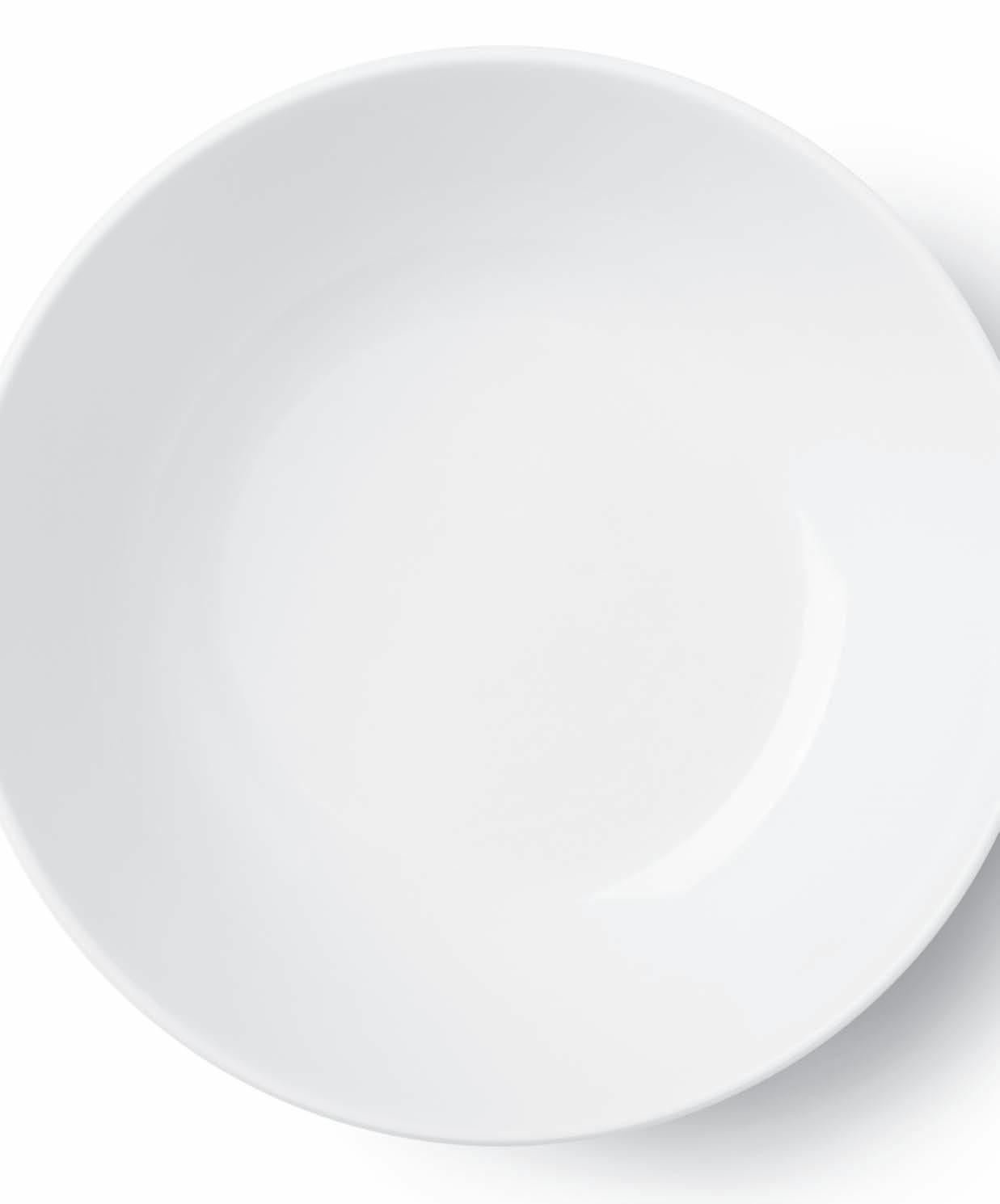
Folate!



(FOLATE IS SUPER IMPORTANT FOR MOMS-TO-BE! PUT THESE NUTRIENT-RICH FOODS ON YOUR PREGNANCY PLATE FOR A HEALTHY HELPING OF THIS VITAL VITAMIN.
What’s so special about folate, you may ask? is B vitamin is crucial for preventing birth defects of the brain and spine, such as spina bifida and anencephaly. ese defects happen in the fi rst several weeks of pregnancy, often before women even know they’re pregnant. Before you plan on becoming pregnant, be sure to get











GREEN VEGGIES LIKE ASPARAGUS, BRUSSELS SPROUTS, BROCCOLI AND OKRA
)your daily recommended amount of folate. Start taking a multivitamin with folic acid, which is the synthetic form of folate that’s used in supplements and fortified foods (like bread, cereal, pasta, rice and other grain products). For a tasty way to get your fi ll, put folate on your plate with these foods:



ORANGE JUICE (100% IS BEST) AND TOMATO JUICE


















FRUITS LIKE PAPAYA, ORANGES, GRAPEFRUIT, STRAWBERRIES AND BANANAS

















BEETS, CAULIFLOWER AND SQUASH




BEANS AND LENTILS

AVOCADO








SPINACH AND ROMAINE LETTUCE










All women should take a daily multivitamin with at least 400 mcg (micrograms) of folic acid. Pregnant women need to bump that up to 600 mcg. Some moms-to-be may require more than 600 mcg—ask your healthcare provider if you’re unsure.















GREEN PEAS AND BLACKEYED PEAS














FLAX SEED




PEANUTS AND SUNFLOWER SEEDS

COLLARD, MUSTARD AND TURNIP GREENS




SUMMER HUNT, ELS, is editorial coordinator for publications at AWHONN in Washington, DC, and writer for Healthy Mom&Baby.


ISSUE 23 / 2017 Healthy Mom&Baby 19 IMAGES © SHUTTERSTOCK healthy moms
BY RACHEL JOSEPH, PHD, CCRN; MARISSA GIOVINAZZO; AND MEGAN BROWN

Your Baby’s Placenta? Is It Safe to Consume


Placentophagia (consuming the placenta) is becoming increasingly trendy as more women partake in this practice. But why? And is it safe?


Your placenta is pretty incredible: is organ develops during pregnancy to provide your baby with nutrients and protection. But would you ever consider blending it in a smoothie or cooking up a piping-hot placenta lasagna? It may sound strange, but there are many moms who do it even though there’s not a lot of research on it and experts advise against it.
INCREASING POPULARITY OVER TIME
Proponents of consuming the placenta say it helps prevent illness; it’s also a way to celebrate the placenta and baby’s birth. Recently, the influence of celebrity moms and their emphasis on natural living have likely led to more mamas considering placenta consumption.
QUESTIONABLE BENEFITS
Although most studies on placentophagia have found there are no significant benefits for postpartum women, many mothers who have consumed their baby’s placenta disagree. Common beliefs about the benefits range from nutritional value and pain relief to prevention of postpartum hemorrhage, increased breastmilk production and decreased risk of postpartum depression. Other potential benefits may include improved mother-baby interaction and increased iron levels. However, there is a lack of evidence to support these claims.

PREPARATION METHODS
One of the most common preparations is drying the placenta and putting it into capsules. Other women opt to cook the placenta before eating. A Google search turns up recipes using the placenta as a meat substitute or in lasagna, pizza, truffles, tacos and more. Raw placenta can be consumed immediately after birth, as small pieces or in a smoothie, however, this is unappealing to most women and is the least popular method.
ASSOCIATED RISKS
Like any other health supplement, placenta consumption is not approved by the FDA. According to the CDC, no standards exist for processing placenta for consumption, and the placenta encapsulation process doesn’t necessarily eliminate infectious pathogens. For these reasons, the CDC says that “placenta capsule ingestion should be avoided.”
In July 2017, the CDC released a report detailing a case from 2016 in which a mother brought her sick newborn to the hospital, where the baby was diagnosed with group B strep. While mom tested negative for the infection, the pills made from her placenta contained group B strep, and she was transferring the bacteria to her newborn.
BOTTOM LINE: DISCUSS WITH YOUR CARE PROVIDER

It’s clear that more research needs to be done to determine the risks and benefits of placentophagia. Talk to your midwife or pregnancy care provider about their experiences with placenta consumption until the evidence is fully in on the safety and efficacy of such.
Placenta isLatin for “pancake.”


RACHEL JOSEPH, PHD, CCRN, is an assistant professor; MARISSA GIOVINAZZO and MEGAN BROWN are senior nursing students; all authors are with the Department of Nursing at West Chester University of Pennsylvania in West Chester, PA.

20 health4mom.org IMAGES: SHUTTERSTOCK healthy moms
PREVENT
Cytomegalovirus
IN PREGNANCY
BY JULIE ZIMMERMAN MSN, RNC-OB, C-EFM
is common virus can cause serious complications for your baby—learn how to protect yourself and your little one.
Are you among the 9 out of 10 women who have never heard about cytomegalovirus (CMV)? is common infection can cause devastating problems for your gestating baby.
CMV is a herpes virus; other herpes viruses include chickenpox, cold sores (herpes simplex virus 1), shingles, genital herpes (herpes simplex virus 2), and Epstein-Barr (mono).
More than half of all adults have been infected by CMV by age 40, the CDC estimates, and most don’t even know it because they don’t experience any symptoms. is stealthy virus, though, can be very dangerous for people with weakened immune systems, like pregnant women.
CMV aff ects as many as 1 in 150 births each year, making it the most common congenital viral infection in the US. More children will have disabilities due to CMV than those with fetal alcohol syndrome, Down syndrome, spina bifida, HIV/AIDS or congenital rubella, say experts at the National CMV Foundation.
Only 1 in 10 babies infected by CMV show symptoms at birth. CMV’s impact on a newborn’s health can be devastating: It can cause preterm birth, hearing loss, microcephaly (small brain), impaired development or death.
HOW DOES CMV SPREAD?
CMV spreads through direct, prolonged contact with body fluids (saliva, urine, breastmilk). It can also be spread through sexual contact with an infected person. Having a toddler in your home also puts you at higher risk as CMV is very common among this age group—especially if they attend day care.
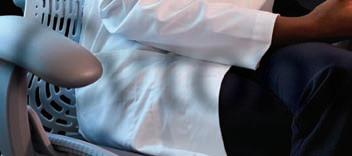
You can pass CMV to your baby if you experience a fi rst-time infection while pregnant. However, women with CMV can still breastfeed infants born at full term, as healthy infants and children who contract CMV after birth have few if any symptoms or complications.
HOW IS IT TREATED?
There is no cure for CMV. However, antiviral medication may decrease the risk of health problems and hearing loss in newborns who show signs of infection at birth. Preventing CMV infection during pregnancy is your best defense.
JULIE ZIMMERMAN, MSN, RNC-OB, C-EFM is a labor and birth nurse at the BirthCare Center at Unitypoint St. Luke’s in Cedar Rapids, IA.
More children willhave disabilities dueto CMV than thosewith fetal syndrome,alcohol Downsyndrome, spinabifida, HIV/AIDS orcongenital rubella.
REDUCE RISK OF CMV IN PREGNANCY
To reduce your risks of CMV in pregnancy:

Wash your hands immediately after
» wiping a young child’s nose or drool

» changing diapers
» feeding a young child
» handling children’s toys
Never put a pacifier in your mouth
Avoid contact with saliva when kissing a child (try “nose” kisses instead)
Don’t share food, utensils, drinks or straws
Don’t share a toothbrush

ISSUE 23 / 2017 Healthy Mom&Baby 21 IMAGES: SHUTTERSTOCK healthy moms
IF BABIES COULD ONLY TALK, THEY’D TELL MOMMIES TO BUY TABLETOTE

Tabletote Laptop Stands are the perfect travel item for busy women on the go! What are you waiting for? Head over to Amazon.com to order yours TODAY
The first cloth diaper that closes shut when soiled, uses ONE remarkably thin insert making it the thinnest diaper on the market, and diaper inserts that are re-used lined inside toddler underwear to potty train!





Sometimes finding a convenient workspace is no easy task. A solution to the problem is TABLETOTE Laptop Stands. Tabletote is the perfect travel companion that can be used anywhere that a stable work surface doesn’t exist. This convenient workspace sets up in seconds and without tools. Improve work efficiency and productivity with either of 2 available models - Original or Plus. Both weigh less than 3.5 lbs and comes with aluminum telescoping legs, allowing height adjustment from 12” to 29”. Tabletote is compact and portable, with legs and accessories neatly stored inside the table. A clever slideoff bottom becomes an extension of the top, allowing work space to be increased from 13” to 22”.
Both models easily fit in backpacks and laptop carrying cases. With retail prices between $27.99-$29,99, Tabletote is attractively priced. Compare to other laptop stands selling for $75 or more. PC Tables, the manufacturer of Tabletote, has been in business for over 16 years and is a trusted and reputable company. With over 130,000 sold worldwide, order yours today and see why consumers have been raving about these nifty laptop stands.


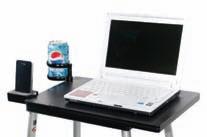
For more information, visit pctabletote.com or call 314-265-7071.

Health benefits of cloth on your bundle of Joy:

- Earlier & easier potty training
- Promotes growth & development as a special bond & interaction develops - Chemical-free to protect skin and guard against irritation

- Organic cotton is unbleached & has NO pesticides or chemicals

















- Hemp and bamboo fibers make our diapers anti-bacterial and hypoallergenic. This protects the top skin layer, which isn’t fully mature until age 1-2 from skin infection and irritation.

- Diaper creams OK











COST: Full set of our budgetfriendly cloth $500 lasting 2-3 kids verses $4000 per child in disposables!
Founded by a nurse & mom Enter Code: HEALTHYBABY for 25% off




www.kashmirbaby.com



Tabletote
Scan for Product Catalog
SKIP SUGARY DRINKS IN PREGNANCY

Before you pop the tab on your soda, drink this in: Women who consume sugary drinks during their 2nd trimester are more likely to have heavier children. In fact, your soda habit during pregnancy can be a stronger predictor of your child being heavier later in life. Researchers looked at 8-year-old boys and girls who had at least a half a serving a week of sugary beverages and found their weights were about 2.2 pounds more if their mothers drank at least 2 sugary beverages a day while pregnant. Hydration is super important when you’ve got a bun in the oven—perk up plain water with some fresh fruit and pass on the pop.
BY SUMMER HUNT, ELS
Protect against life-threatening pertussis






Getting the Tdap vaccine in pregnancy is highly effective at protecting your developing baby from pertussis (whooping cough) after they’re born, say researchers. In a study, the Tdap vaccine was 91.4% effective during a baby’s first 2 months and 69% effective in the first year. You can get the Tdap shot between 27 and 36 weeks to maximize your transfer of protective antibodies to baby. Pertussis can affect anyone, but it’s especially dangerous to infants and can even be fatal.


Panic, Anxiety & Pregnancy


Having a panic or anxiety disorder during pregnancy doesn’t contribute to complications, say experts in JAMA Psychiatry. If you’re dealing with a panic or anxiety disorder or depression, you don’t have to suffer in silence—talk to your healthcare provider about how you’re feeling and what sort of treatment would be safest for you. Researchers also found that treatment with benzodiazepines and selective serotonin reuptake inhibitors (SSRIs) was associated with some increased risks for experiencing the side effects of these medications.

23
IMAGES © SHUTTERSTOCK ISSUE 23 / 2017 Healthy Mom&Baby Pregnancy
Join us on Facebook facebook.com/HealthyMomAndBaby
1st Trimester
Ask Our Nurses:
Morning
DOES MORNING SICKNESS MEAN I’M HAVING A GOOD PREGNANCY?

It’s no secret that nausea and vomiting in pregnancy is very common—and it can be morning-noon-andnight sickness that lasts the whole pregnancy! Up to 80% of all pregnant women experience nausea and vomiting in pregnancy, what we call morning sickness. Maybe you take this as a good sign as some studies associate morning sickness with a healthy pregnancy—but that’s not always a comforting thought in the heat of the heaving.
It’s not exactly known, but the hormones hCG (the pregnancy hormone that makes pregnancy tests positive) and estrogen are said to trigger it. Nausea and vomiting can begin as early as 4 weeks of pregnancy; it usually peaks around 8 weeks. For most women, it subsides after the end of the 1st trimester (about 14 weeks). But for 10% of unlucky moms-to-be, it can last the whole pregnancy.
—Susan Peck, MSN, APN
HOW WILL MY BODY CHANGE IN PREGNANCY? WHAT SHOULD I EXPECT?
Common changes in your body during pregnancy include but aren’t limited to the following:
Mood swings: Repeat after us, “Mood swings are normal!”
Increased breast volume and size— the girls may be sore or tender and leak a yellowish pre-milk called colostrum
Expanding belly and stretch marks—90% of pregnant women get them
Swelling in hands, face, legs, ankles and feet—


your blood volume and other fluids increaseby as much as 50%—get plenty of rest and relaxation to minimize swelling
Increased need to pee, especially at night— you get a bit of a break in the 2nd trimester
Back pain— gentle exercise, walking, stretching and good posture will help prevent pain
Nausea— although this should subside for most by week 14
If you experience any sudden symptoms, or changes that are extreme or worrying, please see your healthcare provider right away.
– Carolyn Davis Cockey, MLS, LCCE
WITH SO MANY OPTIONS, HOW DO I CHOOSE THE RIGHT PRENATAL VITAMIN?

A daily prenatal vitamin is your insurance against any deficiencies from conception through pregnancy and breastfeeding. Not all prenatal vitamins are created equally, and not all supplements have been tested for safety in pregnant women.
Choose your prenatal carefully and stick to meeting your basic needs—think maximum impact with the minimum number of daily supplements. Too much vitamin A can be harmful to your baby and is often reduced in prenatals; this is one reason why a regular multivitamin isn’t appropriate during and after pregnancy. Skip herbal supplements— many are considered too risky for baby. Discuss herbs or other supplements with your healthcare provider before you take them.
—Tamera Young, RN, MSN
ask our nurses

with

Your questions answered by our expert mother/ baby nurses at health4mom.org/ ask-our-nurses.
Sickness, Prenatal Vitamins, Your Changing Pregnant Body Look for a prenatal
the following: Folic acid: 400 mcg Vitamin D: 400 IU Vitamin C: 70 mg Vitamin B12: 6 mcg Vitamin E: 10 mg Thiamine: 3 mg Riboflavin: 2 mg Niacin: 20 mg Zinc: 15 mg Calcium: 200-300 mg Iron: 27 mg 24 health4mom.org IMAGES: SHUTTERSTOCK healthy pregnancy
pregnancy
2nd Trimester:
Negative Blood Factor?
HOW YOUR RH STATUS CAN AFFECT YOUR BABY
BY JENNIFER LEMOINE, DNP, APRN, NNP-BC
A positive or negative Rh factor doesn’t affect your health status, but it may affect your pregnancy.
Early in pregnancy, your healthcare provider will order a blood test called a type and screen (T&S) to determine your blood type and Rhesus (Rh) factor.

ere are many different major blood types; categories include type A, B, AB, and O blood. e Rh factor is a protein on the surface of red blood cells. If you have this protein, you’re Rh positive (most people). If you don’t have it, you’re Rh negative.
Just like your blood type, your Rh factor is inherited. If mom and dad are Rh positive, then baby will be, too—and if they’re both Rh negative, same goes for baby. If both you and your partner are Rh negative, Rh factor won’t be a concern during your pregnancy. However, if you’re Rh negative and your baby is Rh positive, you and your baby have what is called Rh incompatibility.
RH INCOMPATIBILITY & RH SENSITIZATION
During pregnancy, you and your baby’s blood supplies are separate; blood exchange occurs primarily at birth. However, there are times when a small amount of your baby’s blood could enter your bloodstream. When mom and baby have Rh incompatibility, this could cause problems. Baby’s blood could enter mom’s bloodstream during:
Amniocentesis
Bleeding during pregnancy
Chorionic villus sampling (CVS)
Elective abortion
Ectopic pregnancy
Miscarriage
Blood transfusion
RH IMMUNOGLOBULIN (RHIG)


Rh immunoglobulin (RhIG) is a medication that can be given by injection to prevent Rh sensitization in Rh-negative women. You may know it by the brand name RhoGam®. Depending upon the manufacturer, the drug may be called by a different name.
If your blood is Rh positive, you won’t need RhIG. For women with Rh-negative blood, the following applies:
Before birth: At your fi rst visit, your healthcare provider will do an additional blood test to see if your body has already formed antibodies that could harm your developing baby. If this has happened, you’re not a candidate for RhIG administration.
If you haven’t become sensitized during this or a previous pregnancy and your baby is either Rh positive or unknown, your provider will likely give you a standard dose of RhIG around your 28th week.
After birth: A blood sample will be taken from the umbilical cord after you give birth. If your baby is Rh positive and you haven’t become sensitized during this pregnancy, you’ll get a single dose of RhIG within 72 hours after birth. In the majority of cases, this additional dose will prevent you from making Rh-D antibodies.
If your baby’s blood type is Rh negative, then you won’t need RhIG.
JENNIFER LEMOINE, DNP, APRN, NNP-BC , is an expert adviser to Healthy Mom&Baby.
ISSUE 23 / 2017 Healthy Mom&Baby 25 IMAGES: SHUTTERSTOCK healthy
healthy pregnancy
BY JOANNE GOLDBORT, PHD, RN



3rd Trimester
PREPARE FOR NATURAL CHILDBIRTH
Natural birth doesn’t have to be scary or intimidating. If you prepare mentally and physically, it can be beautiful and empowering.
Learning about natural childbirth helps reduce birthing fears.
Do you desire a natural birth, where you’ll wait for labor to begin on its own, move through labor upright and out of bed in positions that help your baby descend? Do you want to work through the contractions, foregoing pain meds or an epidural?
Your body is designed to labor and birth; use these 5 strategies to prepare for what can be a very empowering and beautiful way to complete your pregnancy and welcome your new baby.

1STUDY UP
Attend childbirth classes that focus on normal vaginal birth, such as Lamaze childbirth classes. Learn the many effective coping strategies that can be used to shorten labor, change the intensity of your contractions, prevent pain signals from reaching your brain and reduce anxiety. Begin with well-known websites, books and classes that support normal birth.
2FOCUS ON YOUR BIRTHING GOALS
Find a provider who supports your natural birthing goals— whether that’s an obstetrician, certified nurse midwife or family practice physician. Ask for their advice on preparing to birth naturally where you plan to labor and welcome baby. Maintain a realistic view of childbirth: Watch natural birth documentaries and real birth videos online. Avoid watching birthing reality shows that are designed more so for ratings than education and support.
3SEEK SUPPORT
Surround yourself with supportive individuals and likeminded moms who will boost your spirits and keep you
grounded. During your 2nd trimester, consider fi nding a doula, a trained birth professional that will provide physical and emotional support before, during and after childbirth. If you’re planning to birth in a hospital setting, ask if doulas are available or for a nurse who will support your desire for a non-medicated birth.

4TRUST YOUR BODY & PREPARE FOR BIRTH
Prepare physically for birth through healthy exercise, yoga, strength exercises or water aerobics. Get plenty of rest, take your prenatal vitamins and maintain a healthy diet with lots of hydration.
5
CREATE A POSITIVE ENVIRONMENT AND BE FLEXIBLE
Create a positive environment, reduce the lights, noise and room temperature and bring your favorite music, relaxation tapes or a pleasant photo to focus on. Be open to how your birth experience unfolds, including any interventions that may be needed so that you and baby can have the best possible outcomes.
JOANNE GOLDBORT, PHD, RN, is an assistant professor at Michgian State University and an expert adviser to Healthy Mom&Baby.
26 health4mom.org IMAGES © 123RF
Keep in Touch

Twitter


on
@Health4Mom
Follow
Silicon Valley Innovation Arrives In Baby’s Room






New Moms everywhere are discovering Cocoon Cam, the most innovative and award-winning baby monitor of the year. Cocoon Cam uses smart detection technology called Computer Vision to monitor your baby’s breathing. The tiniest of movements are tracked via an HD video camera while they’re sleeping in their crib. The lightweight system installs in less than five minutes, monitors your baby’s breathing in real time (without a wearable or mat) and sends proactive alerts right to your smartphone. You’re notified right away when your baby needs your attention, and the simple smartphone app includes sleep tracking, cry detection, and even personalized content for your baby’s development stage.
With notifications sent right to your phone, you’re always connected to your baby. Whether you’re down the hall, across town, or traveling the world. This means you can enjoy a date night out, or head back to work, without worry.


Cocoon Cam makes tracking your baby’s sleep and vital signs easy, affordable and seamless. It’s the only baby monitor that combines high quality, secure HD video and audio with contactless vital sign monitoring. All in one easy to use system that communicates directly with your smartphone. So you can always see, hear, and know your baby is breathing easy.
Innovative Body Suits

Retired Entrepreneur/Interior Designer turned Inventor, Janet DeMaria, developed a NO SNAPS! Infant Bodysuit called a SKADOOSIE®. She took up babysitting to give that extra helping hand to parents with infants and small children soon after her husband’s passing. Upon realizing the Onesie® hadn’t changed in 20 years since her son was a baby....she turned a 139-year-old idea into a more viable product for today’s busy working Moms, Dads & Grandparents.


DIFFERENT
SKADOOSIE® Offers Applique Services & Matching Baby Hangers for a small fee. A % of each sale is donated to Mesothelioma Research Foundation in memory of her late husband to find a cure for Asbestos Cancer.





Visit www.skadoosie.com for more information.


SO, WHAT’S
WITH SKADOOSIE®? • NO SNAPS! • USA Made & Patented • No Overhead Application...goes on like a Blouse • Baby Soft Velcro® Fasteners • Unique Rear Diaper Check Slot (eliminates the “smell test”) • Dads & Arthritic Friendly • Comes Gift Ready for that last minute Baby Shower Gift
As a reader of Healthy Mom & Baby, you can take $20 off your purchase of Cocoon Cam with code HEALTHYMOM. To get your Cocoon Cam system today, visit www.cocooncam.com and enter the coupon code at checkout. https://cocooncam.com/ discount/HEALTHYMOM
CO-ED CELEBRATION
healthy
 BY SUMMER HUNT, ELS
BY SUMMER HUNT, ELS
Shake UpYour Next Shower!Baby
Baby showers are the latest time-honored tradition to get a more modern makeover. Gone are the days of watered-down punch and boring games—nowadays, showers are full-on celebrations that are fun for everyone. Take a cue or two from these creative ladies when it comes time for your own shindig:
Take

































THINKING OUTSIDE THE (PIZZA) BOX
Jennifer King (Alabama), mom to Penelope Grace



Jennifer’s mom and sister were opting for a traditional event until a relative’s bridal shower featured a make-your-own pizza party. “I loved the idea!” Jennifer says. “I thought it wasn’t something many women have done before and would give guests something to do. I worried about people being bored, especially if there’s too much time sitting around, just watching the mom-to-be opening gifts.”
Upon arrival at the pizza parlor, guests were given salad, bread and a meatball appetizer as they mingled. Jennifer made her pizza first so she could eat a few slices and get to work opening gifts. Friends and family were able to work on their own pies, including sliding their creations into the brick oven. Assorted flavored cupcakes from a beloved local bakery topped it off.
“It was such a memorable party and a great way to celebrate my daughter’s impending arrival,” Jennifer says. “I heard from a lot of people that it was one of the most creative showers they’d ever been to! It meant a lot to us that everyone enjoyed themselves.”
Rebekka Lucas (Oklahoma), mom to Lucille Evelyn
When Rebekka was pregnant with daughter Lucy, she decided to ditch the ladies-only luncheon vibe in favor of a more laid-back


gathering for guys and gals. “We both have large, very tight-knit families and wanted everyone to feel included,” she explains. “It wouldn’t have felt like my baby shower if my dad wasn’t there. We had plenty of fun stuff to keep everyone busy—kids and men included!”

Instead of cards that would be read once and tossed aside, Rebekka opted for something more memorable: “I asked everyone to pick their favorite storybook instead and sign it with a note to her.” Books have become essential for Lucy, too, as she was diagnosed with unilateral hearing loss after being born premature. “The number-one thing you can do to improve listening and spoken language is to read,” Rebekka says, “and now we have plenty of material!”
Rebekka chose her favorite mini lemon Nothing Bundt cakes boxed up as a takeaway gift. “Most people don’t eat cake at weddings and showers, so I thought they could enjoy them at home,” she explains. “I think that may have been everyone’s favorite!”
Jennifer slides a homemade pizza into the oven at her pizza party shower.
Jennifer and husband Jermaine welcome daughter Penelope.
Rebekka is all smiles after a day with family and friends.
Rebekka with daughter Lucy.
A pregnant, glowing Jennifer.
Rebekka shows off a gift at her co-ed celebration.
KING;
ISSUE 23 / 2017 Healthy Mom&Baby 29
pregnancy IMAGES © SHUTTERSTOCK; JENNIFER
REBEKKA LUCAS
healthy pregnancy
Diaper thoughts: “Everyone writes funny or encouraging notes on diapers that we’ll use later,” says Jennifer. “I know they’ll be fun to read during those late-night changes!” (Note: If you’re worried about permanent marker rubbing off, have guests decorate sticky notes toplace on loose diapers instead.)
Insta-game: Provide a creative hashtag for guests to use on Instagram and give a prize for best picture. Later, scroll through your virtual photo album. #Winning!
Diaper raffle: “People are given the option to bring a pack of diapers, any size, if they want to be entered into the raffle for a prize,” Rebekka says. “We had diapers for DAYS!”

PARTY-PLANNING TIPS










Provide that personal touch: Love brunch? Have breakfast-themed bites. Star Wars fanatic? Take that theme and run with it!
Headband station: “We had all the headband-making supplies ready—ribbons, bows, flowers and hot glue,” Rebekka explains. “Even my uncles joined in on the fun.”
Have a designated friend take pictures. You’ll be too busy to think about it, but you’ll treasure those snapshots later.
Get guests to write their names and addresses on envelopes when they arrive to make mailing thank-you notes a breeze.






Name that price: Stage your own baby item-themed Price Is Right game. Closest guess without going over wins! (Bonus: Mom gets to keep baby items.)

Keep it simple. Too many games or activities will take away from the fun.
Baby faces: Have guests send along baby pictures of themselves ahead of time. At the shower, play name that baby!







SUMMER HUNT, ELS, is editorial coordinator for publications at AWHONN in Washington, DC, and writer for Healthy Mom&Baby.
Don’t overthink it! If the food is good and the conversation is flowing, everyone is sure to have a grand time.
For more pinspiration, check out our Shake Up Your Shower board on pinterest.com/healthymombaby.
HERE ARE SOME MORE INNOVATIVE IDEAS TO TRY OUT, INCLUDING SOME FROM JENNIFER AND REBEKKA:
30 health4mom.org


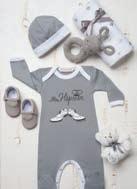


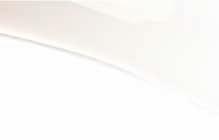














CURATED BABY GIFT SETS • UNIQUE & PRACTICAL BABY MUST-HAVES • GIFT WRAPPED FOR AN IMPRESSIVE PRESENTATION WWW.THEBABYGIFTBOX.COM / THEBABYGIFTBOX the Brands you Love · Packed with Love. BONUS! Sibling Gifts included with every purchase! Relax knowing your baby is protected Car crashes are the number one risk of injury to an unborn baby.* Tummy Shield™ is the safe & simple solution for directing seat belt pressure away from your baby bump while driving. Fits All Cars in Seconds Crash Tested Firefighter & Healthcare Provider Recommended *US Library of Medicine SafeRide4Kids.com $10 off with code TSHMB23 through 2.28.18
The original expert in full support nursing bras built into stylish tanks and tops.

20% OFF – enter code H4MGM17 at checkout. Valid thru 5/1/2018.

glamourmom.com
By Joanne Gold B ort, Ph d , rn
Choose Your Birth Environment
2 registered nurses: 1 caring for you and 1 for your baby. If you have a high-risk pregnancy, a NICU team may also be there for support.
As soon as you become pregnant (or even before you conceive), explore your options and decide what type of care provider you want to guide and support your pregnancy journey. Find providers you can connect with and trust and who will be there to assist in the labor and birth processes. Don’t be afraid to ask questions and arrange facility tours as you explore the best place to safely birth your baby.
98% of women in the US birth in a hospital even though there are birthing center and home birth options. In choosing your provider, you’re also inadvertently choosing where you will birth by where your provider practices. For example, if you choose a certified nurse midwife (CNM) for your pregnancy care, typically midwives can care for you at a hospital or a birthing center— and some do home births as well. Most physicians are primarily hospital-based.
Hospitals
Most American women birth in a hospital, attended by either a board-certified physician or a certified nurse midwife and usually
You’ll be able to have your partner or other support people, including a doula, with you. Typically, you would labor in a hospital room on what’s called an LDR (labor, delivery, recovery) unit; once baby is born, you would move to the mother/baby unit—sometimes called the postpartum area until you’re ready to go home. For a normal birth, you would stay in the hospital for up to 48 hours, and up to 72 hours following cesarean.
Expect baby to room in with you; newborn testing or screening can typically be done at your bedside. If baby has to go to a different part of the hospital, ask anyone preparing to move your newborn for their hospital photo ID. You can also have your partner or a support person accompany baby for any procedures or screens apart from you.
Birt H Centers
Birth centers are typically operated by either certified nurse midwives or certified professional midwives. Research shows this is a great choice if your pregnancy is progressing normally and without any elevated risks; it’s your best choice if you’re having a healthy pregnancy and want a natural birth without electronic fetal monitoring, intravenous fluids or pain relief drugs.

You have choices when it comes to birthing your baby—consider the options and decide what’s best for you!
ISSUE 23 / 2017 Healthy Mom&Baby 33 healthy pregnancy IM aGe S: S hU tter S to CK; th In KS to CK
healthy pregnancy
CNMs are trained to identify any risks during your pregnancy and refer you to an obstetrician or perinatal specialist, if necessary. Birthing centers aren’t typically an option for moms carrying multiple babies or who are experiencing high-risk complications such as high blood pressure, which could lead to a condition called preeclampsia. If at any time there is an emergency during labor and birth, you would be transferred from the birth center to the nearest hospital via ambulance.
In a freestanding birth center, you’ll find a more home-like environment. You’re typically in a private bedroom like you would have at home, you wear your own clothing, can have as many support persons as desired including a doula, and you’re not restricted to bed. You can eat light foods and drink fluids; there may also be options for laboring and birthing in water. Your midwife will use a handheld Doppler to periodically check your baby’s heart rate in lieu of continuous fetal monitoring.
You and your partner will actively participate in the labor and birth processes, supported by your midwife and their assistants. You’ll typically go home within 6-8 hours after baby’s birth. Your midwife will follow up with you in person and by phone in the coming days.
Some hospitals also operate birth centers for moms who want a more home-like birth; still there may be more medical intervention depending on their policies and procedures. To be considered true birth centers, they must meet certain standards for independence and must be separate from the hospital’s labor and delivery unit. Certified nurse midwives typically staff these centers with a separate nursing staff. Like a freestanding birth center, you’ll need to have a low-risk pregnancy to birth in this environment with plans to forego any drugs for pain.
In either type of birth center, the midwives and nurses are well educated on various birthing options and positions, such as standing or squatting, and can offer many different types of comfort measures such as hydrotherapy, birthing balls and relaxation techniques.


Homes
A small percentage (<1%) of American women have home births, typically attended by a midwife. A home birth allows more control over the environment—it is your home, after all! You and your partner create your birthing environment and experience as you desire. Your midwife will help you determine how to set up the room for the birth and will bring all the necessary items to safely bring your baby into the world.
Though home births are more common in other parts of the world, birth is considered more of a medical event in America. As such, the American Congress of Obstetricians and Gynecologists (ACOG) recommends that births take place in a hospital or birth center that meets required standards. However, ACOG also states that women have the right to make medically informed decisions about birth, and that they support care by certified nurse-midwives.
Joanne Goldbort, Ph d , rn , is an assistant professor at Michgian State University and an expert adviser to Healthy Mom&Baby.
34 health4mom.org
Orgasmic Birth is real! It happens when you feel safe, private and unobserved to activate the release of your love and pleasure hormones. Birth hormones are easily disturbed just as an intimate moment might be. Imagine trying to stay in the mood if a stranger walked in, turned on bright lights, began asking you questions and hooked you up to a monitor - birth requires the same privacy! With the right conditions - support, comfort, and respect - birth can be an experience full of joy, pleasure, and the hormonal ecstasy that nature intended. A Birth filled with LOVE is an Orgasmic Birth!
Orgasmic Birth parents share their top 3 tips for preparing to have a birth filled with love, pleasure and power!
1. Movement - Just as you wiggle your tight jeans on, baby needs you to move allowing them to find their way. Try dancing, swaying and circling on a ball.
2. Sensual Touch - Activate the hormones of love with kissing, stroking - anything that turns you on will release your labor hormones.

3. Rhythm - Find your own beat for birth. Singing, listening to music or drumming throughout birth can give you focus and help you to find comfort.
Science is telling us that there are safer and healthier ways to give birth. It does not have to be filled with pain and fear. Transform your views and birth with love and joy. Watch the award winning documentary Orgasmic Birth: The Best-Kept Secret and receive FREE tips to create the birth you desire.
www.OrgasmicBirth.com
ALL MOTHERS ARE WONDER MOTHERS
WONDER MOTHER FOR NURSING MOTHERS

Wonder Mother Effervescent Dietary Supplement was developed by a mom, for moms, to supplement the dietary and hydration needs of breastfeeding women.
Wonder Mother tablets dissolve in water to create a refreshing lemon/lime flavored drink filled with minerals, electrolytes, herbal extracts, and probiotics.
BREAST IS BEST
All mothers want what is best for their babies, and most will try breastfeeding their newborns. Almost 4 million babies were born in the US last year that's a lot of milk! Wonder Mother is here to provide nutritional support for moms busy making milk for their babies.
Our Effervescent Dietary Supplement for Nursing Mothers contains ingredients to support a breastfeeding mother's diet, and we believe that coupling nutritional supplementation with hydration is a great way to fill two needs with one deed!
MINERALS + ELECTROLYTES + HERBAL EXTRACTS + PROBIOTICS
Our tablets contain macro and trace minerals to support a lactating woman's physical health, sodium and potassium to aid hydration, herbal extracts of Raspberry leaf, Blessed Thistle, and Alfalfa believed to support normal milk production, and probiotics to support healthy digestion*.

A COMPLETE LINE OF SUPPLEMENTS
Wonder Mother will launch energy and multi vitamin formulas in 2018. Look for them!
All our formulas are vegan and gluten free.
Find us at THEWONDERMOTHER.COM

Buy us at AMAZON.COM
*This statement has not been evaluated by the Food and Drug Administration. This product is not intended to diagnose, treat, cure, or prevent any disease. Please consult your doctor or healthcare professional before consuming any dietary supplement.
Did you know that birth can be Pleasurable?









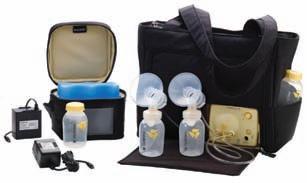







@BeliBeaBra www.facebook.com/BeliBeawww.belibea.com info@belibea.come @belibeabra • Perfect combination of comfort and functionality • Seamless stretch fit • Dual panels for nursing and pumping • Smooth, sleek shape • Wire-free One bra for both breastfeeding and hands-free pumping convenience NOURISH byBeliBea 20% OFF code: hmb2017
BY CHARLOTTE WOOL, PHD, RN
Prepare for Breastfeeding
You can meet your breastfeeding success with a little planning, support, patience and these checklists!
ere’s no better way to feed your baby than with your own breastmilk. Experts including the World Health Organization (WHO) and the American Academy of Pediatrics (AAP) recommend that infants only breastfeed or consume breastmilk for their fi rst 6 months of life. ese same experts also encourage you to nurse your baby for at least their 1st year and into their 2nd year and beyond, as you both desire.
While breastfeeding is normal and natural, you may still face challenges along the way. Use these breastfeeding success strategies and recommendations to achieve the nursing you desire with baby.
DURING PREGNANCY
Tell your family and friends about your breastfeeding plans; ask for their encouragement and support with your other children, housework and meals. Join an online breastfeeding support group and ask other nursing moms what strategies they found most helpful when beginning breastfeeding. Find nursing moms through Women’s, Infants & Children’s (WIC) programs,


La Leche League or through nurses at your local hospital.
Talk with your nurses at your healthcare provider’s office. Ask their advice on breastfeeding, including how to fi nd a local breastfeeding class, a nursing support group, and a breastfeeding friendly healthcare provider for baby.
Take a breastfeeding class; ask how you’ll be supported to start and continue breastfeeding where you plan to birth. Ask about the policies where you plan to birth regarding beginning breastfeeding in the fi rst hour after baby emerges—even if baby is born via cesarean. Specify that you want to “room in” with baby to support your early nursing together.
Choose a “Baby-Friendly” designated birthing center or hospital, which means healthcare providers there are committed to helping moms and babies create breastfeeding success.
Get familiar with your changing breasts. You
healthy pregnancy

Breastfeeding at Birth
Breastfeed as soon as possible after birth, including cesarean birth


Keep your baby close to you, holding them skin-to-skin
Room together but don’t bed share for sleeping
Breastfeed frequently—every 2-3 hours

Learn baby’s hunger signs and cues
Get advice from your nurses and lactation consultants



Try different nursing positions
Delay pacifiers and bottles until breastfeeding is natural for you and baby
ISSUE 23 / 2017 Healthy Mom&Baby 37 IMAGES: SHUTTERSTOCK; THINKSTOCK
healthy pregnancy
may start making your first milk, colostrum, as early as 16 weeks. Learn how to express your milk by hand. If you’re concerned about having flat or inverted nipples, have a history of breast surgery, or take medications, meet with your provider or a Certified Lactation Consultant to make a plan for nursing your baby.
Check your health insurance benefits to see what’s covered to support breastfeeding; register for nursing supplies before any baby showers you may have. Many plans cover breast pumps, milk storage bags, bottles and other breastfeeding supplies.
At BABy’s Birth
When your baby is born, hold them skin-to-skin right away; your partner can do this too when you’re relaxing. Ongoing skin-to-skin care is the perfect way to start and sustain breastfeeding.
If you haven’t had medication through labor and birth, baby will likely be born awake, alert and ready to feed in that first “golden hour.” Holding baby skin-to-skin keeps them warm, helps them hear your heartbeat, feel your breathing, and smell the milk. Ask your nurses to delay their assessments as possible until after baby’s first feeding or for at least the first hour after birth.
When you’re tired and need to rest, the safest place for baby is in their bassinet beside your bed. Rooming together will help you to learn when they are hungry; you’ll learn their hunger cues so that you can respond to their needs.
Feed baby every time they seem hungry, and allow them to remain at the breast for as long as they desire—many babies often fall asleep at the breast and there’s no need to wake them. Just hold them close, keep them warm, and snuggle.
During the earliest days, your baby needs to nurse about 8-12 times every 24 hours, which works out to be about every 2-3 hours. You may even need to rouse baby to feed if they’ve slept more than 3-4 hours.

Your nurses will help you find comfortable nursing positions, particularly if you’re also recovering from cesarean. The best nursing position is the one that feels comfortable to both you and your baby. Help baby into position and as you bring baby to your breast, look for a deep latch that includes a tugging feeling at your breast. If you’re unsure if baby is latching on correctly, ask your nurses to watch baby latch and begin to feed; they want to help you get the best possible start and are eager to share their expertise.
Delay a pacifier for 3-4 weeks; this lets baby learn how to breastfeed and helps your milk come in. If you’re separated from your baby for any
reason, support your milk supply by expressing your milk with your hands or a breast pump as regularly as baby was nursing at the breast.
sustA ining n ursing
Getting through the first few days and weeks can be tough. You will be tired and adjusting to new routines. Your breasts may become suddenly full and your baby’s eating patterns may change. You may question whether you have enough milk, or if you should begin pumping because you have so much milk. Breasts can get tender and nipples sore.
This is the time to ask for help! Partners can burp your baby, change diapers, and make sure you have plenty of food, water, and rest. Keep a feeding and diaper log. Follow your baby’s hunger signs and allow baby to regulate your milk supply through nursing. Talk to other moms online or call your nurse or a breastfeeding specialist.
You will want to get out of the house, so do! Breastfeeding is convenient on the go. Your breastmilk is always the perfect temperature and you don’t have to worry about extra supplies or pumping.
Most experts recommend waiting 3-4 weeks before pumping regularly to ensure baby has the hang of breastfeeding. If you’re returning to work or school, plan to take pumping breaks throughout the day and know your rights regarding these breaks. State and federal laws exist to protect nursing moms. Plan for a place to store your milk and clean your supplies.
Sustaining Breastfeeding
B Accept help from loved ones
B Breastfeed on demand
B Keep a feeding and diaper journal
B Allow baby to regulate your milk supply
B Gather with other nursing moms for support
B Use nursing covers or tops at your preference to nurse in public
Charlotte Wool, PhD, r N, is an expert adviser to Healthy Mom&Baby.
38 health4mom.org
1 Prepare Now!
Breastfeeding Basics




It is paramount to prepare for breastfeeding before giving birth. Get educated by talking with your nurse, taking childbirth and nursing classes, reading books, and watching videos.
2 Create A Nursing Sanctuary
Keep in mind that you must to be comfortable and everything you need is within arms reach. Have a comfortable chair to sit and rock in. Gather lots of comfy pillows to support your low back, arms, and hold the baby in a good position while you nurse.
3 Nourishment
Your body is amazing! It can grow your baby, birth your baby, and it can feed your baby. But if you want your body to perform the way you want it to then you need to nurture it with healthy foods, lots of water and plenty of rest.
4 Get Support
New mothers should be nurtured mothers. It takes a village to grow a child and it takes love and support to take care of nursing moms. Sometimes you need to seek advice from an expert or find a local breastfeeding support group. Those women who are trying to solve all their nursing problems alone, feel alone.


5 Stay Steadfast

DonÕt give in to the fear and the nay sayers-You can do this!




This product has not been evaluated by the FDA. It is not intended to treat, diagnose or cure any disease.



Save 46% more of your precious breastmilk effortlessly, just by wearing Lacti-Cups. Don’t waste your milk in nursing pads. Created by a Clinical Lactation Consultant, inspired by moms and their babies. More info: www.Lacti-Cups.com
By Helen Hurst, D n P, rn C, AP rn -C nM
I’m Pregnant & Bleeding
What Could This Mean?
Bleeding during pregnancy can scare moms-to-be; however, not all bleeding during pregnancy is a sign that something is wrong.

As many as 1 in 4 women experience bleeding at some point during pregnancy. Understanding the different types of bleeding and possible causes may put your mind at ease and help you know when to call your nurse, midwife or doctor.
If you experience bleeding, your healthcare provider will want to determine why you’re seeing blood, and if you need urgent care.
SpottI ng or BleedI ng?
Spotting is a few drops of blood, often lighter in color than your period, that you see when you wipe with a tissue.
Bleeding is heavy enough to soak through a panty liner or pad.
�
Call your care provider if you have cramping with bleeding in pregnancy.
! 40 health4mom.org Images: s hutterstock healthy pregnancy
s potting: Spotting is typically a small amount of blood or blood-tinged mucous that you only see when you wipe with tissue after going to the bathroom, or you may see a few spots on your underwear.
In early pregnancy, spotting may mean the embryo is implanting into the wall of the uterus (implantation bleeding). It often occurs about 2 weeks after you miss your period and shouldn’t continue or progress to bleeding. Also, a vaginal infection that irritates your cervix or vaginal tissues can cause spotting, as can normal changes in cervical cells due to pregnancy hormones.
You may also notice pink or brown mucous-like spotting up to 12 hours after intercourse with your partner. Pregnancy hormones make your cervix soft; the blood vessels can become engorged and bleed easily. If you report spotting, your pregnancy provider will likely ask you when you last had sex.
m iscarriage: Bleeding in early pregnancy can be a sign of miscarriage. This type of bleeding is usually bright red and heavier, more like a period, and may be painful, crampy. Any bleeding that’s accompanied by cramping needs further evaluation; please call your pregnancy care provider and describe what you’re seeing and experiencing.
Ectopic pregnancy: An ectopic pregnancy occurs when an embryo implants outside of the uterus, usually in a fallopian tube. If you have an ectopic pregnancy, you may see light or heavy bleeding, and this bleeding is often accompanied by pain or cramping on one side of your abdomen. The cramping can be mild or severe. But you may have no evidence of bleeding. You’re at greater risk for an ectopic pregnancy if you became pregnant with an IUD in place or have had pelvic infections, a previous ectopic pregnancy or surgery on your fallopian tubes.
o ther causes for early pregnancy bleeding: Another possible cause of 1st trimester bleeding is subchorionic hemorrhage or hematoma, which is bleeding between the membrane of the placenta and uterine wall. While it can be serious, it doesn’t always lead to miscarriage. You may also see a persistent dark brown discharge in early pregnancy; let your healthcare provider know if this persists as your pregnancy progresses.
Middle- to late-pregnancy bleeding (often after 20 weeks) is usually due to placenta previa or placental abruption. Know the symptoms so you can immediately call your healthcare provider if you experience either of these problems.
Placenta previa: Placenta previa occurs when the placenta implants in the lower part of your uterus. In doing so, it may cover part or all of your cervical opening, which is called the cervical os. Bright red, painless bleeding may signal a placenta previa.
Your healthcare provider will use ultrasound to check for previa. Typically, a placenta previa will resolve without problems. The bleeding usually subsides and the pregnancy continues in about 90% of cases. If the bleeding becomes severe, your healthcare provider may request you receive care and support in the hospital.
If you have a placenta previa, avoid sex, particularly intercourse and orgasm, as these activities can stimulate contractions and cause bleeding. With a previa, nothing should be placed in the vagina and your providers should not perform vaginal exams.
Placental abruption: Placental abruption is rare and requires urgent care; it occurs in about 1% of pregnancies. Placental abruption is just like it sounds—some or all of the placenta separates from the wall of your uterus. It can be life-threatening for you and your baby.
You may see dark or bright red vaginal bleeding and have moderate to severe abdominal pain. Your abdomen may feel very tender or hard to the touch; you may feel like you’re having constant contractions. If you experience these symptoms, contact your healthcare provider or call 911 and go the hospital. Depending on the extent of the abruption and bleeding, you may need an emergency cesarean. If it isn’t severe, you may be able to continue your pregnancy with more frequent visits and ultrasounds.
If you’ve had either a placenta previa or placental abruption in a past pregnancy, you’re at a greater risk in future pregnancies. Share this important fact with your healthcare provider if you become pregnant again.
Helen Hurst, Dn P, rnC, APrn -CnM is an expert adviser to Healthy Mom&Baby
Early Pr E gnancy Bl EE ding: 1st t rim E st E r (12 w EE ks or l E ss)
m iddl E to l at E Pr E gnancy Bl EE ding: 2nd & 3rd t rim E st E rs
Vaginal bleeding affects about 25% pregnancies.of
41ISSUE 23 / 2017 Healthy Mom&Baby healthy pregnancy
Don’t miss out









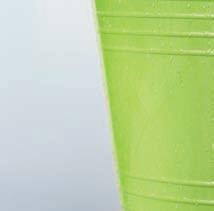
















Follow us www.facebook.com/HealthyMomAndBaby
us on Facebook





Say Bye-Bye
 BY SUMMER HUNT, ELS
BY SUMMER HUNT, ELS
Babies healthy


If you’re using a sound machine to lull your little one off into dreamland, listen up: Many sound machines designed for babies can actually reach noise levels that can be harmful to infant ears, especially if the device is very close to baby (like on a night table next to their crib). That doesn’t mean you have to lose sleep—experts say sound machines are still okay to use, with these tips in mind: Place it far away from baby, keep the volume low and only use for a little while, not all night.


Babies should not have fruit juice in their first year of life, says the American Academy of Pediatrics (AAP). This is the first time this particular advice has been updated since 2001. Care providers say juice offers no nutritional benefits to growing babies, and high sugar content could lead to tooth decay. Encourage little ones to eat fresh fruit instead, which has more fiber and less sugar. After 1 year, juice should still be limited. Here are the daily limits as recommended by AAP:

• Ages 1-3 years: 4 ounces
• Ages 4-6 years: 4-6 ounces
• Ages 7-18: 8 ounces or 1 cup
On the search for a one-of-a-kind baby name? Take a peek at this list of “endangered” names—once at the top of the charts, these are on their way to becoming distant memories.
ISSUE 23 / 2017 Healthy Mom&Baby 43
Join
facebook.com/HealthyMomAndBaby
to ese CUT THE JUICE LOOSE PLAY IT SAFE FOR SOUND SLEEPING( ( IMAGES © SHUTTERSTOCK



 Kepi Support Swaddle + Lounger's patented design provides your baby the head, neck, and spine support it needs. The only swaddle that reduces the risk of Flat Head Syndrome, Hip Dysplasia, and unnecessary anxiety in parents and newborns. The Kepi allows the whole family - parents, siblings, and grandparents - to hold and pass the baby with confidence.
Kepi Support Swaddle + Lounger's patented design provides your baby the head, neck, and spine support it needs. The only swaddle that reduces the risk of Flat Head Syndrome, Hip Dysplasia, and unnecessary anxiety in parents and newborns. The Kepi allows the whole family - parents, siblings, and grandparents - to hold and pass the baby with confidence.
World's Safest Swaddle. ORDER NOW ShopKepi.com 20% Off Code: KEPI-P
Protect your Newborn. feedback Send us your feedback and comments! health4mom@awhonn.org
By Michele Savin, D n P, MS n , nn P-B c
Understanding Trisomy:
chromosomal a bnormali Ties in babies
Trisomy happens when a baby is born with an extra chromosome; you may have heard about it as Down, Edwards or Patau syndromes.
Trisomy means a baby’s cells have 3 copies of a chromosome instead of the typical 2. When this happens, the baby experiences physical and developmental delays. These chromosomal changes are named according to which chromosome is affected. The most common are trisomy 21 (Down syndrome), trisomy 18 (Edwards syndrome) and trisomy 13 (Patau syndrome).

Trisomy 21
Trisomy 21 is one of the most common chromosomal abnormalities; it affects 1 in every 700 babies born each year. Infants with Down syndrome have physical and intellectual differences that vary widely and can’t be predicted before birth. Physical features that may suggest Down syndrome include a flat-looking face, upward slanted eyes and low-set ears. A baby with Down syndrome may have poor muscle tone and struggle with feeding. They need the same routine care as all children including vaccines and regular check-ups. An infant with Down syndrome may also need to have their heart, vision, hearing and digestive health monitored.
Trisomy 18 & Trisomy 13
Edwards syndrome (trisomy 18) is the second-most
common trisomy condition; it occurs in about 1 in 5,000 births. Trisomy 13, or Patau syndrome, is the third-most common, affecting 1 in 16,000 newborns. These are both much more serious than trisomy 21, and most infants born with these chromosomal abnormalities won’t survive their first year of life; in fact, many babies with trisomy 18 don’t survive pregnancy to term.
r isk Fac Tors
It’s true that older women have a higher risk of chromosomal differences in pregnancy. However, more babies with trisomy are born to younger mothers simply because younger women have more babies. Age is a risk factor for trisomy, but so is a genetic and family history on both parents’ sides. If your baby is born with suspected trisomy or has facial and body characteristics that are common with trisomy, your baby will have a blood test called a karyotype. A picture is taken of the chromosomes, and the pairs are matched. If a third chromosome is found with any of the pairs, then the specific trisomy is confirmed.
Michele Savin, Dn P, MSn , nn P-Bc , is an expert adviser to Healthy Mom&Baby
healthy babies
Diagnosing Trisomy
Healthcare providers screen for trisomy with blood tests in your 1st or 2nd trimesters or with ultrasound. If screening suggests trisomy, you may choose to undergo further diagnostic testing. This can be riskier and may cause a small number of women to miscarry; tests include:
B a mniocentesis, where amniotic fluid is extracted from around baby between 15-20 weeks
B c horionic villus sampling , where tissue is taken from the placenta at 1013 weeks
B cordocentesis , in which blood from the baby’s umbilical cord is extracted at 18-22 weeks; this test is considered riskiest for baby
ISSUE 23 / 2017 Healthy Mom&Baby 45 images: s HUTT eRs TOCK
Tips in Caring for your l ate Preterm infant
By Carolyn Davis Co C key, M ls , lCC e
Babies born just 3 to 6 weeks early are at a greater risk for potentially serious health problems than babies born at term. In the last 6 weeks of pregnancy, baby usually gains about ½ pound a week, so babies born a few weeks early are typically somewhat smaller than full-term newborns. Although late preterm infants may look like full-term infants, they are still premature and have their own unique health risks and needs.
5 Key Care Cues for Late Preterm Infants:

1Feeding: Late preterm infants tend to feed slower and may need to be fed more often. They may also struggle to get enough breastmilk or formula. Feed your baby born early often, especially in the first days following birth. If baby begins to refuse feedings, contact baby’s nurse or pediatrician. Your baby born early may struggle to coordinate sucking and swallowing when nursing; ask for help from a lactation consultant while you’re in the hospital and consider attending a lactation group once you’re home with baby for extra support and help.
2Sleeping: Late preterm infants can be sleepier than babies born at term; you may need to wake baby every 3-4 hours for feeding. Always place your baby on their back to sleep, in an infant-safe crib or bassinet with only a tight-fitted sheet and no toys or pillows. It’s important that baby sleep in their own crib in your room during the first year of life.
3Breathing: Late preterm infants can have problems with breathing; call 911 if baby seems to struggle with breathing or is turning blueish.
4Temperature: Late preterm infants have less body fat and may struggle to maintain a normal body temperature. Keep your baby away from drafts; room temperatures should be warm enough for baby to sleep comfortably in one more layer of clothing than you’re wearing. Don’t overdress baby or allow baby to get overheated.
5Jaundice and infections: Late preterm infants can be more likely to develop jaundice, a symptom of a bigger problem called hyperbilirubinemia, which can lead to severe nervous system damage if not identified and treated early. Ask your baby’s pediatrician or nurse if baby has been screened for jaundice before leaving the hospital. Infants should be seen by their nurse practitioner or pediatrician within 24 to 48 hours of discharge. Notify baby’s care provider if at any time baby’s skin or eyes become yellowish. Late preterm infants have immature immune systems and more easily develop infections. Contact baby’s care provider if baby has a fever (more than 100.4 degrees) or difficulty breathing.
Carolyn Davis Co C key, M ls , l CC e, is editor of Healthy Mom&Baby.
46 health4mom.org image: SHUTT e RSTOCK healthy babies
Double leg elastic and secure hook & loop closure prevents leaking

Why Cuddle Buns Preemie Diapers?

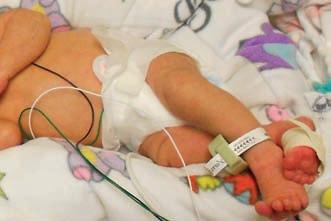
A unique preemie diaper with an hourglass shaped pad and very narrow crotch to keep tiny legs aligned
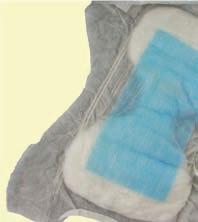
Narrow core helps keep legs in a comfortable position for normal growth and development*
Better for the Baby
Better for the Nurse Better X3
Better for the NICU
Cuddle Buns Preemie Diapers have an hourglass configured pad, no gel core and narrow core to help ensure premature babies’ legs are in a comfortable position and to promote normal growth and development. In addition, our preemie diapers are available in 3 sizes, have a hook & loop closure (no tape), a cut-out for the umbilical cord and urine samples can be taken directly from the diaper, making Cuddle Buns diapers beneficial for babies. www.small-beginnings.com | 800-676-0462
*Source: An independent opinion survey of more than 150 nurses conducted in August 2016 at COINN

– Council of International Neonatal Nurses
SwaddleDesigns is the brand that so many parents trust



New parents around the world have wrapped their babies in soft cozy fabrics for thousands of years. This time honored tradition helps babies as they transition from the womb to the world. Our premium muslin swaddles are super soft and feature our helpful pictorial how to swaddle label with safe sleep reminders sewn to the edge of the blanket.





Wrap with LOVE®
SwaddleDesigns founder is a registered nurse. Our newborn essentials are designed with baby’s best interest in mind and your style at heart. Our swaddles are more than a blanketuse as a burp cloth, play mat, nursing cover, and over the stroller. Recommended by nurses, doctors, and newborn care educators, SwaddleDesigns essentials are registry must-haves and favorite baby gifts.
sleeping sacks swaddles stroller blankets burp cloths bibs lovies apparel
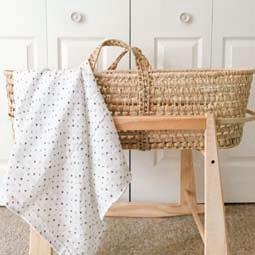
• • StylishQualityEssentials
New Mom Favorite Registry Essential Woman Owned Business SwaddleDesigns.com
By Tonia olS on, M n , BS n , R n , i BC lC & a ngela Bowen, P H D, M eD , BS n , R n
Breastfeeding & Postpartum Depression
la CTaT ion C onsulTan Ts answe R you R ques T ions
)
babies
Can breastfeeding C ause postpartum depression (ppd)?


Not all women at risk for or currently experiencing depression find breastfeeding too stressful to maintain, or that it worsens their moods. While research suggests that struggling with breastfeeding can increase the risk of depression in some women, establishing good breastfeeding protects against depression.
Moms with PPD and who stopped breastfeeding early actually described to researchers feeling more depression and anxiety when talking about their moods. The feel-good hormone, oxytocin, which drives the let-down reflex essential to beginning each breastfeeding session, helps you feel relaxed and content. If you’re struggling with breastfeeding, remember that both you and your baby are going through a lot of changes right now.
is it safe to take mediC ations for depression while breastfeeding?
Newer antidepressants transfer in small amounts only into breastmilk and don’t negatively affect your baby. In fact, research shows that moms with anxiety may safely take anti-anxiety drugs, like benzodiazepines, while breastfeeding with only a slight increase of sleepiness in some babies. Also, moms with bipolar disorder can take mood stabilizing drugs such as valproate, phenobarbital, phenytoin and carbamazepine.
Experts caution against using antipsychotic medications clozapine and olanzapine if you’re depressed and experiencing psychotic symptoms. Some recommend that if you’ve safely taken a drug effectively before lactation, you should talk to your healthcare provider about continuing that same medication while breastfeeding.

Remember, using any medication while breastfeeding is an individual decision that’s best made in consultation with your personal healthcare provider.
i’ve been Cautioned that breastfeeding will make me lose more sleep, potentially inCreasing my feelings of depression—is that true?
There’s an assumption that moms who feed their babies formula get more sleep or free time than moms who breastfeed—but research proves that this is not the case. While lack of sleep definitely affects anyone’s mood—especially new moms—feeding formula doesn’t improve sleep or mood, particularly because of how it affects the hormone prolactin, which helps you make milk and sleep.
Prolactin is the primary hormone responsible for milk supply and it also promotes deep sleep in adults, research shows. Because of this, studies report that exclusive breastfeeding actually improves mother’s sleep. One group of researchers found that parents of breastfed infants slept an average of 40-45 minutes longer each night than parents of babies who were fed formula.
Tonia o lson, M n , B sn , R n , i BC l C, is a maternal-child nurse and lactation consultant with the Saskatoon Health Region in Saskatoon, Saskatchewan, Canada. a ngela Bowen, PhD, M eD , B sn , R n, is associate professor and researcher at the University of Saskatchewan, Saskatoon, Saskatchewan, Canada.
Question #3
(
Question #1 Question #2
ISSUE 23 / 2017 Healthy Mom&Baby 49 images: shutterstock healthy
babies
By Charlotte Wool, Ph d , rn
Provide Comfort & Care during d ia P ering to avoid Stre SS ing Ba By
Does diapering stress your baby? Do you race to make that change in record time? You may not know it yet, but you can slow down and intentionally diaper with comfort and care to reduce pain and avoid stressing baby.
Babies have an uncanny knack of being able to pick up the emotional “temperature” of a room. When parents are distracted, bickering or upset, your baby may sense it and feel stressed. Studies show babies can even tell the difference between happy and angry body language.
Whether you realize it, your baby is “reading” you every time you change their diaper. How you act, touch, talk and care for baby during this time has an effect on baby’s health and well-being.
Calming Comfort during diapering
For some babies, diapering is stressful. They don’t like lying flat on their backs; they don’t like having their legs moved. They don’t always cooperate with dressing. They squirm; they fuss. Are they stressed? In pain? Hard to tell unless you know how to read your baby’s signals and cues.
Since babies aren’t born speaking our preferred language, they communicate through facial expressions, body movements and sounds like cooing or crying. It’s frustrating when you want to help but don’t know how. Being sensitive to and aware of your baby’s cues is a terrific first step in responding.
Your baby gives you a chance to master their likes, dislikes and tendencies with every diaper change. If your baby tends to fuss during a diaper change, you can respond in physical and reassuring ways that will help them feel better about your time together.
Babies also love routine—diapering rituals, like making funny faces and sounds, hugging your baby and ending your changing session with some snuggle time can teach baby that diapering can be an expected and rewarding interaction.

proteCtive powers of physiCal affeCtion
Researchers have found that physical affection has protective powers. Your hugs, cuddles and caresses have protective effects. Just keep in mind not all babies like the same kind of touch or attention—your job as a parent is to learn your baby’s preferences.
If baby is particularly fussy, skin-to-skin contact can help them relax by slowing and calming their breathing, for example. You might try rocking your baby or using a cradle or swing. Young babies particularly like to be swaddled; take time to learn the proper technique if your baby is comforted by this snuggly wrap. Carrying your baby close while walking around has been shown to increase calm and reduce crying in fussy babies.
Does your baby put their fingers in their mouth? Suck on a beloved toy? Suck with an air-lock grip on a beloved binky? All babies are born with a strong suck reflex—in fact, they began practicing this reflex
50 health4mom.org healthy
image S : S hutter S to Ck












Newborn Skin Care Confidence Advice from nurses on everything you need to care for your little one’s delicate skin in our expert-authored Newborn Skin Care Zone at bit.ly/newbornskin: And More! SPONSORED BY Your Baby’s Skin Mindful Diapering Guide What’s that Rash? Ask Our Nurses Parent Pages Quiz Polls bit.ly/newbornskin Download our free diapering guide at: bit.ly/mindfuldiapering
healthy babies
POINTERS FOR PREEMIES
Most babies spend between 37-41 weeks in the womb. Babies who reach 37+ weeks have spent time developing strong muscles by pushing up against the wall of the womb—moms feel some of those kicks and pushes! Premature babies born before 37 weeks miss out on some of this physical development. Premature babies’ muscles aren’t as strong, but research shows you can help baby gain strength and grow well.
Ask your nurses which positions are best for your preemie, as certain positions are shown in research to enhance feelings of calmness and security, reduce stress, protect baby’s delicate skin, help increase muscle strength, minimize heat loss and evenly distribute pressure on diff erent parts of baby’s body.
If your baby was in the NICU, they likely experienced some painful or stressful procedures. Before going home, ask the nurses to show you how to best position your baby for tasks like diaper changes. As you get to know your baby, you’ll also get a feel for what they like best.
Just like full-term babies, preemies crave sucking on their hands, fi ngers, or a pacifier. You can also try what experts call “facilitated tucking,” which is a safe and eff ective method to reduce pain and stress in preemies. Practice facilitated tucking by holding your baby’s arms and legs close to their trunk. Gently bring baby’s hands together on their tummy and place your hand there as well.
Your baby may avoid eye contact because they feel overwhelmed or overstimulated. Give them time to regroup. Hold, comfort, and reassure them and then smile and re-engage with them when they turns back to look at you. Cues that your baby is experiencing pain may include:
crying that starts suddenly and is louder and longer than when baby typically cries because they’re hungry



increases in breathing or heart rate
posturing, such as arching their back
quickly withdrawing from the painful situation or thing

right at the beginning of the third trimester, which is important for getting all the nutrition they need.
But it’s not always about food, say experts at the American Academy of Pediatrics. Babies practice “non-nutritive” (not food) sucking because it helps them relax, manage their emotions, focus their attention, create feelings of comfort and security, and frankly, fight boredom, say the kids docs. Most babies and toddlers will use sucking as a comfort measure up through their 2nd birthday.
Watch your little one during diaper time: Are they trying to calm themselves with some type of sucking? Offer a favorite toy or pacifier for this time after breastfeeding is going well (typically after baby’s 3rd or 4th week).
MANAGE YOUR MOOD—AND BABY’S
While no one is happy and bubbly all of the time, if you’re more so stressed than not, it’s important for your health, and baby’s, to find ways to manage your stress. Ask your partner, a relative or friend to lend a hand. Consider counseling and make any needed changes in your life to reduce what creates your stress.
Learn how to distinguish stress from pain in your little one, too. ey may look similar, but baby will offer up clues to help you sleuth the differences. Stress in babies typically looks like:

a change in skin color, from pale to red-faced or vice versa
grimacing or scowling
restlessness
waving arms
baby’s body suddenly going stiff or floppy
refusing to make eye contact; intentionally avoiding or breaking eye contact
Respond to baby’s pain-related cries with comfort and touch even as you figure out and alleviate what’s creating baby’s discomfort. During stress or pain, comfort your baby by offering your fingers to grasp, keep your voice and your movements slow and calm, and draw baby’s arms and legs in toward their chest, and move their hands together over their trunk. Place one of your hands on their head and one over their hands. You can also draw baby close into you and hold them tucked in this position as if you’re a human swaddle. If baby will rest against you, try skin-to-skin care and offer a pacifier, toy or your clean fingers to suck.
With a mindful approach to diapering and comforting your baby, you’ll gain your baby’s trust and dependency for their needs—and that’s a healthy boost for you both!
DIAPERING THAT NURTURES YOUR BABY
Your baby benefits from every diaper change when you practice these 5 habits shown in research to benefit baby’s growth and development:
Create a calm and clean diapering environment through good hygiene and supplies at the ready
Change and check baby regularly, such as every 1-3 hours during the day and at every feeding
Comfort baby by moving slowly through the diaper change to minimize any stress or discomfort
Champion sleep by practicing skin-to-skin care at bedtime and using diapers with wetness indicators to avoid disturbing baby’s snoozing
Cherish confidence and closeness that come from learning your baby’s cues and responding to baby’s needs, such as for a clean, dry diaper
Source: Adaped from Huggies® Every Change Matters: A Guide to Developmental Diapering Care.
CHARLOTTE WOOL, PHD, RN is an expert adviser to Healthy Mom&Baby
52 health4mom.org
You’ve got questions but you’re between appointments—what should you do?
Ask a friend?
Wait it out?
Ask an AWHONN Nurse?

Visit Health4Mom.org, post your question and an AWHONN Nurse will answer.

You’ve got questions. We’ve got expert answers.

Yes!
Conception? Pregnancy? BIRTH! health4mom.org/ask-our-nurses
Don’t miss out












Follow us www.facebook.com/HealthyMomAndBaby
BY Charlotte Wool, PhD, rN
Bond
with Your Baby
Parenting isn’t just a responsibility—it’s an opportunity to build a bond with your baby that will last a lifetime. As you see the efforts of your care helping baby engage and trust in you, your confidence will increase and strengthen your bond.
There is no greater joy than becoming a parent. When you first hold your baby in your arms and look into their face, it seems the whole world stands perfectly and wonderfully still. Your excitement at becoming a parent often matches the realization of its awesome responsibility.
You may wonder where to start, and one incredible developmental answer to that is “in the moment.” Parenting isn’t a once-and-done experience; rather it’s a compilation of millions of minutes through the lifetime of your child.
Making moments matter includes viewing some of the more routine parenting tasks as opportunities to build a loving relationship. Transform tasks like diapering from a hurry-to-be-done duty to a moment and activity that is close, care-infused and engaging for both you and baby.
Close ConneC tions
So much is written about the importance of bonding, or the attachment that forms between you and your children. It often begins before birth— before you ever meet your baby face-to-face. It’s not miraculous that your baby recognizes your voice, your scent and remembers your heartbeat at birth— you began this relationship many months ago. As you hold your baby skin-to-skin at birth, those bonds that were formed when baby was in your womb are only strengthened.
Physical and emotional closeness has proven health benefits for you and your baby. Those
babies
Babies androutineslove happilyrespond to fundiapering ritualsyoutogether.establish
first weeks with baby are ripe with opportunity for closeness, especially during breastfeeding, skin-to-skin care, cuddling and the ongoing handson care you give baby, such as during a bath or in diapering.
Each of these opportunities can enhance baby’s health and growth as you take a moment to engage, look into baby’s eyes, sing or hum, and watch your baby to learn how they respond to your touch, warm skin and gentle care.
the power of pre DiC ta B ilit Y
We all thrive on routines—even babies. For your little one, this can include daily events such as nursing, diapering, playing and sleeping. Some families have weekly routines that may include scheduled time for grocery shopping or attending a place of worship.
Routines give us a sense of organization and empowerment yet we all likely know someone who prefers flexibility over routine. For babies, however, research confirms that routines are essential to their growth and development, help babies begin to develop self-nurturing and control, and minimize stress for babies.
Diapering is an excellent time to establish a routine break from household chores or the other pressures of everyday life to connect and enjoy a few minutes with your baby.

As you and baby establish a diapering routine, your confidence in caring for your little one gives
Diapering that nurtures Your BaBY
Your baby benefits from every diaper change when you practice these 5 habits shown in research to benefit baby’s growth and development:
B Create a calm and clean diapering environment through good hygiene and supplies at the ready
B Change and check baby regularly, such as every 1–3 hours during the day and at every feeding
B Comfort baby by moving slowly through the diaper change to minimize any stress or discomfort
B Champion sleep by practicing skin-toskin care at bedtime and using diapers with wetness indicators to avoid disturbing baby’s snoozing
B Have confidence and closeness that come from learning your baby’s cues and responding to baby’s needs, such as for a clean, dry diaper Source: Adapted from Huggies® Every Change Matters: A Guide to Developmental Diapering Care.
ISSUE 23 / 2017 Healthy Mom&Baby 55 images: s hutterstock healthy
healthy babies
you a sense of accomplishment—hey, that is always a good feeling! e emotional closeness between you and baby is maximized as you make the most of your time with your little one by intentionally engaging with them.
Involve all your baby’s senses during diapering (see Baby Senses, Activate!). During awake times for baby, engaging by activating their brain while you both have fun together is a great idea—make silly faces, funny noises and talk or sing to baby. When it’s time for sleep, use a different diapering routine that cues your baby it’s time to calm and prepare for rest—not play. As your baby grows from a newborn to a toddler, add more games and ideas to this playful routine and consider reading or humming softly to baby as he drifts to sleep.
Providing predictable, tender loving care during diapering creates a positive environment for your baby. Research shows that loving care given in an organized, safe way promotes brain development and protects your baby’s emotional and social wellbeing. As you get to know your baby, you’ll come to recognize the opportunities to support their growth and share happy moments as one of life’s greatest blessings.
Encourage other members of your family and friends who may care for baby to adopt a mindful and intentional way of interacting with your baby; they’ll feel rewarded knowing their extra efforts are not only good for their own health but baby’s too!
BABY SENSES, ACTIVATE!
Encourage your child’s development by activating their senses during routine tasks like diapering—here’s how:
Touch: One habit that never gets old is beginning and ending your diapering routine with a loving hug. It can be short and sweet or longer and more relaxed, including skin-toskin time. Many moms say that the simple act of holding their little ones skin-to-skin helps a baby go from crying to calm in no time. When your baby can inhale your scent and feel the warmth of your body, they are quickly comforted.
Infant massage is another option you can integrate into the diapering routine. Benefits include increased bonding and relaxation and reduced crying. You’ll want to pay attention to your baby’s mood before beginning. You

may opt for a brief massage during regular diapering and a more extended session in the evening as part of a sleep time ritual. Every baby is different, so experiment with your schedule and your baby’s likes and dislikes as you aim to bring comfort and contentment into your diapering routine.
Sight: Diapering gives you an excellent opportunity to delight in your baby’s unique mannerisms and features. Babies are born nearsighted and have the best visual focus from about 8–12 inches away. ey love looking at faces, especially their parents! As baby gets older, you’ll notice they can focus better and will often try to imitate your facial expressions as you make a face or move your mouth a certain way. A simple game of Monkey See, Monkey Do is so fun at this stage!
Smell: Full-term babies are born with a keen sense of smell. ey quickly and consistently recognize their mother’s scent. e ability to identify mom’s scent helps them with breastfeeding and is a source of comfort. Of course, diaper time introduces smells other than those associated with comfort! Keep a covered trash bin near the diaper area to discard soiled diapers and wipes.
Hearing: About halfway through pregnancy, your baby begins to detect sounds. Your little one can hear your beating heart and your voice. As they grow in the womb, your baby begins to recognize external sounds and may respond to music or other noises. After birth, you can incorporate rhyming games and music into your diapering routine.
You’ll notice that as your baby continues to grow, they will attempt to mimic sounds by cooing and babbling. Making music together during diaper time is such fun! Sing your favorite songs and expose baby to a wide variety of music depending on the time of day: Try silly songs during the day and softer lullabies at night. Have musically inclined family members? Consider recording them to play for your baby.
POINTERS FOR PREEMIES




Born before 37 weeks, premature babies may need extra help relaxing and remaining calm during diapering. Get to know your baby’s likes and dislikes while he’s still in the hospital and in the early weeks of life so you can respond quickly to comfort him. Talk with baby’s nurses to learn their observations about what stimulates or calms your baby. As baby grows and develops, you should be able to do more with them, such as holding, skin-to-skin care, rocking or nursing—look forward to these times while keeping your intention on engaging with baby in the present moment.
Many babies try to selfconsole by sucking their fingers or thumbs, or bringing their hands to their mouths. NICU babies often use pacifiers to calm themselves.
While in the hospital, you may have seen the nurses intentionally position your baby after a diaper change or swaddle him to help baby feel calm and content. Talk to your care provider about the best approach for this. Preemies respond especially well to skin-to-skin holding, as it activates their senses of smell, touch, and hearing and helps them feel comforted.
As your baby matures they will learn skills to selfregulate or control their behavior, which is a gradual process that begins before birth and extends well into the school-age years. You can help your baby by modeling patience and love at every opportunity.
Source: Adapted from Huggies® Every Change Matters: A Guide to Developmental Diapering Care.
56 health4mom.org IMAGES: SHUTTERSTOCK
Keep in Touch



















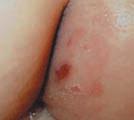







on Twitter @Health4Mom
Follow
Hospitals and nurses make great efforts to ensure that each baby receives the best possible care. Similar efforts should continue when the baby leaves the hospital.
The Baby Safety Snap lanyard (patent pending) helps drivers remember that they have a “BABY IN CAR”. Attached to the highly visible lanyard is a baby seat metal tab that fits all baby seat buckles. The lanyard’s metal tab is snapped into the baby seat buckle when the seat is not occupied. When the baby is placed in the seat, the driver removes the tab from the buckle and places the
lanyard around their neck. The baby is then buckled into the seat.
The driver wears the lanyard until they reach their destination. The driver then removes the lanyard, unbuckles the baby, and snaps the lanyard tab back into the buckle for the next driver. The baby is safe and leaves the vehicle with the driver.


If the baby is forgotten, the visible Baby Safety Snap lanyard worn by the driver will remind the driver, family members, coworkers and even strangers on the street that there is a “BABY IN CAR”.


The Baby Safety Snap can also be customized to include a logo for a healthcare enterprise, professional organization or any other business to show the community that they care about the safety of their children.

On-Line

Every ten days, a baby dies in a hot car.
One in four parents has forgotten a young child or baby in a car.
Shop
BabySafetySnap.com 617-769-0001
By Carolyn “Carrie” J. l ee, PhD, C ne , rn
PreventPoisonings
Your wee ones are interested in their world, but simple household items can be harmful. Keep ‘em safe with these tips.

DANGER: POISON! Adults understand the serious warnings and menacing symbols that tell you something could be dangerous, but to little eyes and curious hands, these are just meaningless squiggles. Anything chemical or items dangerous to babies, toddlers and young children should be locked high and out of sight, recommends the American Association of Poison Control Centers (AAPC). Keep products in their original containers (which list ingredients and safety information).
Be Pre PA red
Prescription and over-the-counter medications, ointments, balms, salves, vitamins and supplements, including herbal or ‘natural’ remedies
Small, shiny lithium ‘button’ batteries—like those in musical cards, older kids’ toys, scales and the like; these can get stuck in a child’s esophagus and result in burns, even death
These small, colorful, squishy packets easily catch a child’s attention: in 2016, aaPC received more than 11,000 reports about exposure to these highly concentrated products in children younger than 5
hair products, makeup, lens solutions, lotions, bubble bath and cleansers; never leave a child younger than 5 alone in a bathroom
Tobacco, e-cigs—and while e-cigs may seem like a healthier alternative for adults, these popular substitutes can make youngsters very sick
even a small amount of alcohol can affect a child’s nervous system and potentially cause trouble breathing, seizures or coma; beyond booze, alcohol is also present in mouthwash, sanitizers and cleaners
Properly store any fertilizers and pesticides out of reach; ask your local garden center or county extension service for information about safer product options
Carbon monoxide is a colorless, odorless gas that undetected can lead to headaches, flushing, nausea, loss of consciousness and even death; install battery-powered carbon monoxide detectors on each level of your house
American Association of Poison Control Centers: (800) 222-1222
Be ready to tell them:
9 Child’s age and weight
Label of the poison from container or bottle if available
Time it happened
Your addressPost the numbers for Poison Control and emergency contacts near all phones in the house and garage. never hesitate to call Poison Control; your information is confidential. If your child is violently ill, has trouble breathing, is unresponsive or passes out, call 911 immediately. DO nOt induce vomiting.
CA roLY n “C A rrie” J. Lee, Ph d, Cne , rn , is an expert adviser to Healthy Mom&Baby.
MeDICat IOns
9
9
9
59 images: s HUTT eRs TOCK ISSUE 23 / 2017 Healthy Mom&Baby healthy babies
Batter Ies Laun D ry Detergent Pers O na L Care PrOD uCts tOBaCCO / e- CIgarettes aLCO h OL an D san ItI zers Lawn/ gar Den Ite Ms an D PestICIDes Car BO n MOnOx ID e the aa PC reports the following items are particularly dangerous to infants, toddlers and young children:
By Michele Savin, D n P, MS n , nn P-B c
n ewborn Thyroid Condi T ions
Though rare, newborn thyroid conditions can affect baby’s growth and development. Newborn screening is essential for early detection and intervention.
Do you know that the small amount of blood that baby’s nurse draws also screens for problems your baby may have with their thyroid? Congenital (meaning born with the problem or condition) thyroid problems need to be caught and treated early.
The T hyroid and i T s role
The thyroid is a small, butterfly-shaped gland on the front of the neck. It sends hormones made by the brain’s pituitary gland throughout your body to regulate bone and brain growth, sexual development and chemical reactions that fuel metabolism. Your heart rate, blood sugar and temperature are all affected by the amount of thyroid hormone in your body.
The pituitary gland produces thyroid stimulating hormone, TSH, which tells your thyroid to make and release the thyroid hormones into your bloodstream. Measuring TSH in baby’s blood at birth helps determine if baby has either of the most common thyroid problems.
hyper T hyroidism
Hyperthyroidism—an overactive thyroid—is extremely rare and usually happens when mom also has it. It affects boys and girls equally and happens in about 1 in every 25,000 births.
Hyperthyroidism can cause problems including small-for-gestational-age babies, premature birth, small head size, fast heart rate, irritability, an enlargement of the thyroid, and possibly eyes that appear to bulge out, called exophthalmos.
If your baby has hyperthyroidism, they may be prescribed an anti-thyroid drug such as methimazole for the first few months
of life. Most infants recover by the end of the third month making early treatment important.
h ypo T hyroidism
If baby’s thyroid is underactive (hypothyroidism), baby’s thyroid gland may not be fully formed. Other causes include a pituitary gland that doesn’t send enough signals to the thyroid, or thyroid hormones that don’t work properly. Most babies don’t initially have symptoms. This happens in about 1 in every 3,000-4,000 babies born in the US. Girls have this problem 2 times more often than boys.

When hypothyroidism is more severe, baby may have a puffy face, thick tongue, jaundice, problems feeding, constipation, poor muscle tone, low temperature, large fontanelles or “soft spots” on the head and dry skin.
Additional blood tests can confirm congenital hypothyroidism if it’s suspected after the first screen. It’s important to start treatment even before the second blood test results are confirmed. Most of the effects of hypothyroidism are reversible with fast and constant treatment in the first 2 weeks of life.
When not treated quickly, infants with hypothyroidism have a higher-than-average risk of other congenital issues including heart problems, poor growth, hearing difficulties and severe intellectual disability.
Michele Savin, Dn P, MSn , nn P-Bc, is an expert adviser to Healthy Mom&Baby.
60 health4mom.org healthy babies
healthy babies
Vaginal Seeding:
By c at H erine ruH l, cn M, MS
Sound Science or Ju S t a t rend?
Vaginal seeding may sound like a good idea in theory, but healthcare providers are cautioning against it.
Have you heard of vaginal seeding? This is a newer practice some women are considering if their babies are born by cesarean. The idea is that they can bless their newborn with the healthy microbes that baby would have encountered had they passed through the vaginal canal during birth.
These healthy microbes, collectively called the vaginal microbiome, are thought to stimulate a baby’s immune system in a helpful way. Research has shown there may be a decreased risk for autoimmune diseases, asthma and allergic diseases for babies born vaginally. Exposure to mom’s vaginal microbiome at birth is one explanation for the decreased risk. Taking antibiotics during pregnancy or in labor and formula feeding can also change the amount and type of bacteria a baby gets from mom.
Vaginal seeding involves placing a gauze pad in the mom’s vagina for an
Experts caution againstseeding.vaginal
)hour or so before the cesarean and then swabbing the newborn’s mouth, face and the rest of its body with the saturated gauze soon after birth. Only small studies have thus far been conducted on this practice. Some findings show that newborns who receive the microbes via swabbing may not retain all of the healthy bacteria in the same way as a baby born vaginally.

What are the risks?
The biggest risk of vaginal seeding is passing infections to your baby. While some of our microbes benefit our health and wellbeing, others can cause serious, even life-threatening infections for newborns—this includes group B strep, herpes, chlamydia and gonorrhea.
Women should be tested for each of these infections during pregnancy. However, they may not be certain about whether they currently have any of these infections when they give birth, even if tests a few weeks or months earlier didn’t show infection.
In November 2017, the American College of Obstetricians and Gynecologists expanded its advisory released in 2016, cautioning healthcare providers and pregnant women against vaginal seeding because of infection risks and a lack of information about its safety and harms. They recommend against vaginal seeding unless it’s part of carefully controlled research.
Questions remain about vaginal seeding
Researchers still have a lot to learn about the vaginal microbiome. They’ll need to monitor the long-term health of babies born vaginally and by cesarean to know how their microbiomes may have been affected by how they were born, and any variations created by vaginal seeding, if it was done.
Your vaginal microbiome is unique. So even if future research on large numbers of women shows that vaginal seeding helps babies, you’ll still need to be keenly aware about what microbes are present in your own vaginal microbiome before considering vaginal seeding.
Catherine r uhl, C n M, MS, is director of women’s health programs at aWH onn in Washington, dc , and an expert adviser to Healthy Mom&Baby.
(
ISSUE 23 / 2017 Healthy Mom&Baby 61 IMAGES: SHUTTERSTOCK
Simple. Cute. Original.










































potty training












Our small cotton underwear and training pants fit your family’s unique lifestyle. Perfect for
your little one and beyond. tinyundies.com Gender-neutral. Sweatshop-free. 6 months and up. Just like your baby. go online to subscribe: health4mom.org/subscription only $13.95 for 4 issues! If you enjoyed this issue, subscribe now! it’s easy!Healthy Mom&Baby magazine is the expert source for wellness for moms and babies. Make us your resource for the healthiest and best pregnancy and birth possible. PREGNANCY BIRTH PARENTING ISSUE 21 2017 $3.95 health4mom.org CONSIDERING CHOICES IN BIRTH PLACES OOPS! DID I JUST LEAK? POST-BIRTH WARNING SIGNS Parents: Meet Your New Roomie! Latest Safe Sleep Advice MARIJUANA PREGNANCY EMOTIONAL EATING MYTHS ISSUE 19 Spring 2016 $3.95 health4mom.org Here’s how and why POWERED BY OF PRENATALESSENTIALSCARE KICKS COUNT ZIKA ALERT Are You & Baby At Risk? Ouch! Quick Fixes ForBreastfeeding Pains Legal or Not, It’sBad for Baby Our Guide to Every Check Up HMB19.cover-js-fm-2.indd 03/03/2016
By Summer Hunt, e LS
Potty
Training 101
Experts including the American Academy of Pediatrics agree a positive, gentle approach is best when you follow this age-appropriate guide:
Use the correct words for poop and pee and encourage your child to do the same. Change your child often, and encourage them to come to you when they need a fresh diaper. Avoid referring to poop as “yucky”—instead, make diaper changes pleasant.
Introduce a potty chair and toilet by transferring poop from dirty diapers into the toilet. Ask your toddler to sit on the potty chair while you read with or play games with them. Ask them to sit on their potty chair while you use the toilet, or have them observe an older sibling using the toilet.
Potty chair: Your child’s feet should touch the floor when seated. Training pants: These introduce the idea of underwear while minimizing accidents.

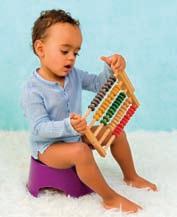
Underwear: Let your wee one choose their underpants, and use underwear as a treat to encourage them.
Let your child pretend to train a beloved teddy bear or baby doll to use the potty. Watch educational videos or read helpful books. Introduce wearing underwear as a privilege. Start practice runs to the potty when you notice your child needs to go.


Once your child has successfully used the potty and understands the process, try what the AAP calls “the bare-bottom weekend.” Commit to several hours with just you and your child—with no interruptions—during which time your child won’t wear any diapers, training pants or underwear (nothing below the waist). This trial-and-error experiment could lead to a major breakthrough for your little one.
Dos an D Don’ Ts
B Do praise your child when they come to you with a soiled diaper or in anticipation of needing a change.

B Don’t discipline or punish your child if they have an accident. Say something like, “you’ll get the hang of this! you’re doing a great job!”
B Do encourage with rewards like animal crackers or stickers—make a little chart to celebrate successes near the potty.
B Don’t get frustrated—children will pick up on your feelings and may become overwhelmed. t here’s no need to rush; it will happen with practice and determination.
AT 18 mon Ths AT
mon T
AT 2+ YeA rs
AT 2 YeA rs
Summer Hunt is
nn
Don’t get down in the dumps helping your kiddo conquer the commode!
21
hs
editorial coordinator for publications at AWHO
in Washington, DC, and writer for Healthy Mom&Baby
Tools of The TraDe ISSUE 23 / 2017 Healthy Mom&Baby 63 images: shutterstock healthy babies
Protect your baby from the effects of GERD reflux, flat head syndrome and LM (laryngomalacia)


The Snuggle Pod by Chibebe is the original baby bean bag! The amazing design of the Snuggle Pod has been proven, through in home use, to help your baby get needed relief from Gerd Reflux and LM during their awake times. It also molds to your baby’s head preventing flat head syndrome. It is easy to clean by simply removing the inner bag liner and washing the rest. You can even add accessories such as the Pod Warmer and Pod Rocker when they need that extra warmth and movement. Your baby will get the comfort and relief they deserve while you get the amazing styles, ease of use, and security of knowing your baby is safe. Get yours today at www.chibebe.com.

West 4th Wraps are soft and mould to your body to give you support and comfort during pregnancy, and to carry your baby until they are a toddler and beyond.
Our wraps are used for comfort measures during pregnancy, for temporary support of mom’s belly, to apply counter pressure in a hip squeeze, and for partner for assisted squats.

Carrying your baby in a West 4th Wrap or RingSling allows for skin to skin contact, that develops an amazing bond between baby and mom and other members of the family.

www.west4thwraps.com Use coupon code “HealthyMom” to receive 10% off your purchase Converts from 0-3M to 3-6M to 6-9M 64 health4mom.org marketplace
PRODUCT
BabyGear

Lamaze Cosimo Concerto®



Mom and baby will love to make music together with Lamaze Cosimo Concerto. This soft zebra plush doubles as a piano for baby to begin playing songs and developing musical skills. Keep baby engaged with surprise crinkles, contrast patterns and multiple textures to explore.



www.lamazetoys.com
King Bio
Everyone needs safe medicine, especially nursing moms (who must be “twice” as careful to keep their babies healthy). Dr. King’s safe, natural, homeopathic formula in a pure water base, temporarily relieves mastitis and other breast inflammations and discomforts. Easy-to-use oral spray.

www.DrKings.com
Check outtheseapprovedparentfavorites!
Tiny Undies
Tiny Undies has created high quality, eco-friendly baby and toddler underwear for tiny bums! 100% cotton underwear and training pants are great for elimination communication or potty training, helping your little one go diaper-free from as young as 6 months up to 5T. Choose from various cute and gender-neutral designs today at www.tinyundies.com.

Shop Kepi
The world’s first Supportive Swaddle. Shop Kepi’s patented design provides your baby’s head, neck and spine with the support it needs. Reduces the risk of flat head syndrome, hip dysplasia, and unnecessary anxiety in parents and newborns. Allows parents, siblings and grandparents to hold and pass the baby with confidence.
www.shopkepi.com

GUIDE 2
1
3 4 1. 3. 4. ADVERTISING 2. ISSUE 23 / 2017 Healthy Mom&Baby 65
healthy babies
What to Expect Day to Day


Ask about a center’s policies including these common issues:
Behavior: How are fussy babies consoled? What happens when toddlers and children break the rules? Do these actions match your desires?
Sick days: When you must keep your kiddo home, and must you must pay for those days? Many centers provide an allotment of no charge ‘sick’ days.
Vacation: How are staff vacations covered? Do families any vacation days without charge? If so, how does notification work?





BY RITA NUTT, DNP, RN


Choosing
Baby’s Day Care
If you plan to return to work after baby is born, the most important tip in fi nding the best possible day care for your little one is to trust your instincts. When you know baby will be happy, safe and nurtured, you can go to work free of worries.

Start early— while you’re pregnant. Day care providers limit the number of babies receiving care onsite; good centers typically have waiting lists. Ask friends for recommendations, and what they like and don’t like about their current care center.
Visit each place when children are receiving care. It’s likely they’ll all be busy, but they should be peaceful, orderly and caring.
RITA NUTT, DNP, RN, is an expert adviser to Healthy Mom&Baby.
Late pick-up: What are pick up time cut-offs, and do financial penalties apply when missed? Beware hefty late fees!
Unscheduled visits: Parents should always feel that they can visit or observe their child. Ask if video observation is available. Reconsider centers that don’t allow any visits.
VISIT WITH THESE QUESTIONS IN MIND


1. What are the provider-to-infant ratios? The American Academy of Pediatrics recommends no more than 3 babies younger than age 2 for each care provider.
2. How is the center cleaned? Crawling surfaces should be spotless. Examine all food preparation and storage areas; note where breastmilk and baby food are stored and prepared.

3. How safe is the facility? Exterior locks? Security
cameras? Where are exterior doors in relationship to infant rooms? Are fire and evacuation plans and routes posted? How is drop-off and pick-up managed? Who else can pick up your child? Do all employees undergo fingerprinting and background checks?
4. Does the equipment, especially sleep surfaces, meet current recommendations? Are the furnishings modern and in good working order? Are stairs and other fall hazards gated?
66 health4mom.org IMAGES © THINKSTOCK; 123RF
Nobody likes to be rushed, especially babies.
Your baby needs at least a full 40 weeks of pregnancy to grow and develop. Inducing labor even a week or two early is associated with a host of risks, including prematurity, cesarean surgery, hemorrhage and infection.

While it may seem convenient for you or your health care provider, labor should only be induced for medical reasons.
Your baby will let you know when she’s ready to come out, so give her all the time she needs: at least the full 40 weeks.
Download a free copy of 40 Reasons to Go the Full 40 at www.gothefull40.com. The nurses of AWHONN remind you not to rush your baby—give her at least a full 40 weeks! AWHONN PROMOTING THE HEALTH OF WOMEN AND NEWBORNS
The power of hugs.
What hugs mean to baby.
Over 600 medical studies on the effects of human touch prove what moms have always known: Hugs are important.


In fact, more and more hospitals state that they are vital to the healthy development of a child. And the benefits of human touch for babies often extend throughout childhood.
The benefits of hugging.
Every hug sets off cascades of hormones that benefit health and help regulate body temperature. Oxytocin, the hormone released by touch, is even nicknamed the “bonding hormone.” A hug can stabilize heart rate, increase oxygen levels, strengthen the immune system, and reduce crying and stress.

How will you greet your babies?

After the first hug, let the second thing that touches baby’s skin feel just as good. Huggies® Little Snugglers Diapers and Huggies Natural Care® Wipes provide our best care to help keep their skin clean and healthy. And as perfect as the day they were born.



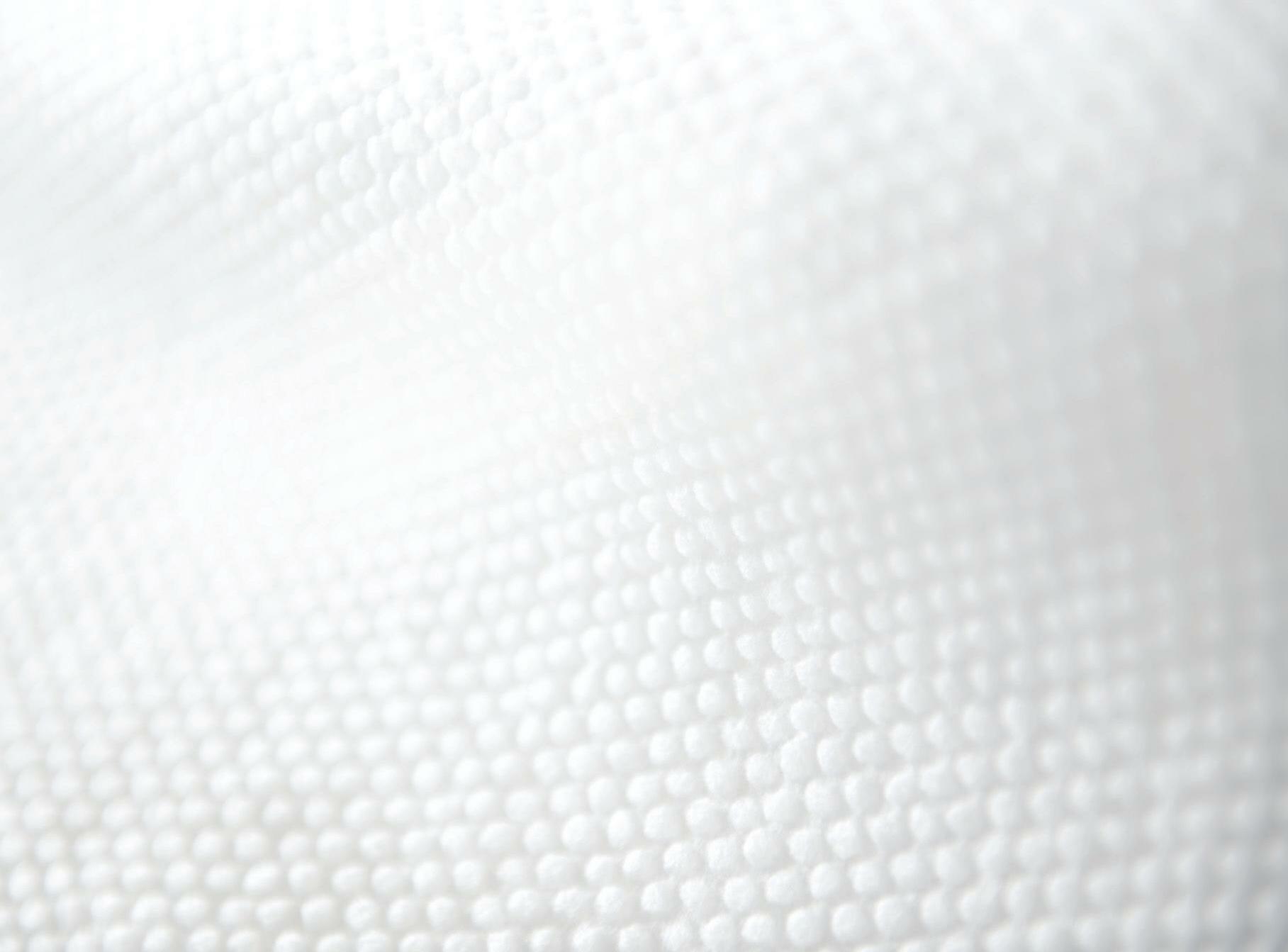
® Registered Trademark and * Trademark of Kimberly-Clark Worldwide, Inc. © KCWW. © Disney. Based on the “Winnie the Pooh” works by A.A. Milne and E.H. Shepard. www.huggieshealthcare.com
